Randi and I signed up for Ironman Maryland TWO YEARS AGO.
It feels weird to type that. My daughter, Jessie, was 6 months old when we registered. I remember feeling totally lost in May of 2020, trying to juggle caring for Jessie and working during the pandemic (along with my amazing partner, James), wondering if I should start actually training for our September race. Thankfully, Randi and I made the decision early enough that we wouldn’t race in 2020, even if IMMD were held. It didn’t seem safe enough. We couldn’t even get into our pools to swim!
Fast forward a year later. I now have a 2.5 year old, I’ve changed jobs, the pandemic is still raging, but things have been normal enough that I was able to train effectively this summer.
To prepare for the race, Randi visited me twice this summer. Randi lives in Minneapolis and I live in Charlotte, so we don’t get to train together often. She and I are super comfortable racing/training together, because we’ve already raced a marathon, half ironman, and full ironman together. She’s also one of my closest friends, and I trust her to be honest if she needs me to change anything about how I’m guiding. During both visits, James was awesome. He handled all of the childcare while we were training. The best part of Randi’s visits was just getting to spend time with her.
This Ironman felt different for me. I had raced 10 full distance triathlons (9 as a guide for blind/vi athletes) before, but this would be my first Ironman since becoming a mom.
Because delta is still raging (and because 2.5 year olds are unreasonable and unpredictable), we decided that James and Jessie shouldn’t come.
So, I headed to Maryland solo to race with Randi.
I picked Randi up on Thursday morning in Baltimore and we drove to packet pickup. Ironman logistics are actually pretty complicated. You have morning clothes bags, bike bags, run bags, special needs bags. You have to drop your bike and run bag in transition the night before the race, BUT you can access them in the morning. You’ll get your bike and run bags after the race, but you WON’T get your special needs bags back, so don’t accidentally put something important in special needs! Anyway, it’s just a lot.
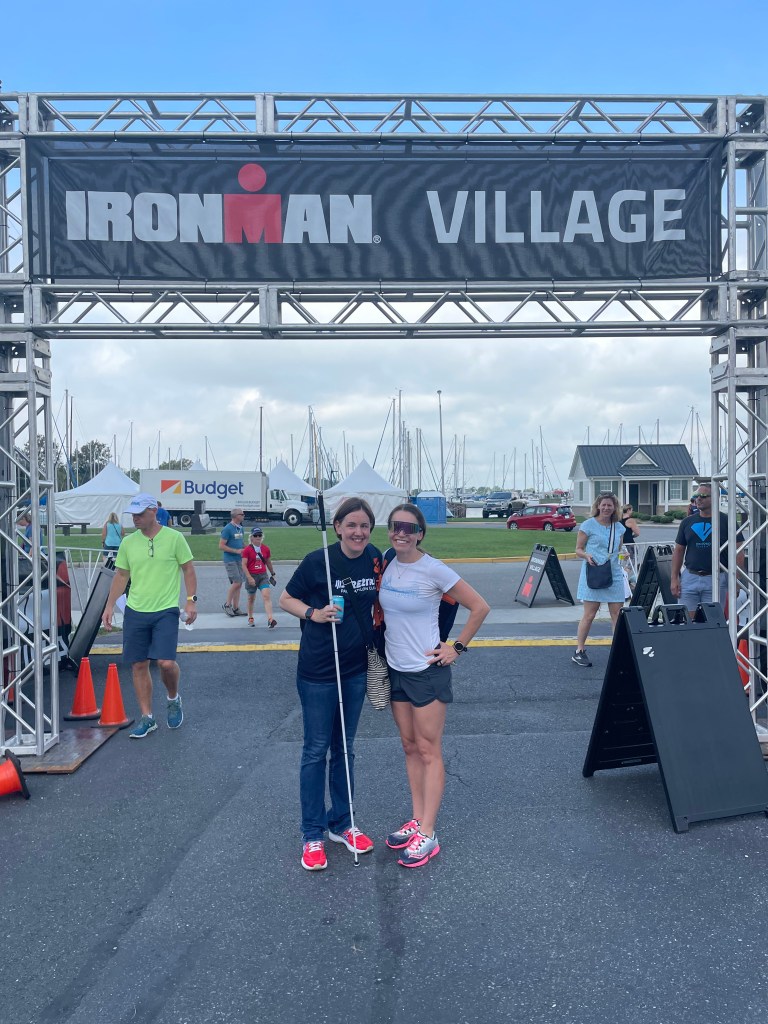
We spent Thursday getting Randi’s tandem dialed in. Every time I guide, for the most part, I have to spend some time adjusting saddle height, saddle position and bar height, to ensure that I’m comfortable during the ride. As you might imagine, being comfortable during an ironman is essential. Thankfully, Randi’s new Hawthorn tandem was pretty close to perfect.
We did a quick test ride and then headed to dinner.
Throughout the weeks leading up to IMMD, we read dozens of posts on an Ironman Maryland facebook group about jellyfish. When I guided the race in 2015, there were no jellyfish at all, because it was so cold. But apparently, in 2019, there were MANY. Initially, I was inclined to hope for the best, and assume that things would cool down enough for the jellyfish to go away.
Unfortunately, it was in the 80s and 90s every day leading up to the race. I started seeing posts about people with pretty intense rashes, talking about how uncomfortable it was. So, Randi and I decided that we should do a test swim on Friday. We thought it would be important to know how our bodies would react to the stings.
Practice Swim
As we walked to the practice swim area on Friday morning, Randi and I encountered a guy that had just finished a swim. I asked him, “How was it?” He responded, “lot of jellies.”
I asked, “but how was it?”
He responded, “lot of jellies.”
That pretty much tells you everything you need to know. The jellyfish were EVERYWHERE.

Randi and I put on our full sleeved wetsuits and covered ourselves with a layer of sea safe (anti-jellyfish cream) and vaseline. Then, we entered the water.
My ankle was stung almost immediately. Some people described the stings as worse than a mosquito bite, but better than a bee sting. It felt like a burning/itching sensation at the point of contact. And we were supposed to keep going deeper into the water???
Finally, we got up the courage to start swimming. There were so many jellyfish, I could feel them with every stroke. It felt like swimming through grass, except the grass was actually tentacles. Randi and I made it about 15 minutes before we headed to shore. As we exited the swim, I was encouraged because I thought we were out of the worst of it. Boy was I wrong. The reaction I had AFTER the swim was far worse than during.
The skin on my wrist between my watch and wetsuit started to swell up. The itching/burning continued throughout the morning. I’m not going to lie, I was getting worried. How was I supposed to bike 112 miles with stings all over my ankles, neck, and wrists? Randi’s stings felt bad as well.
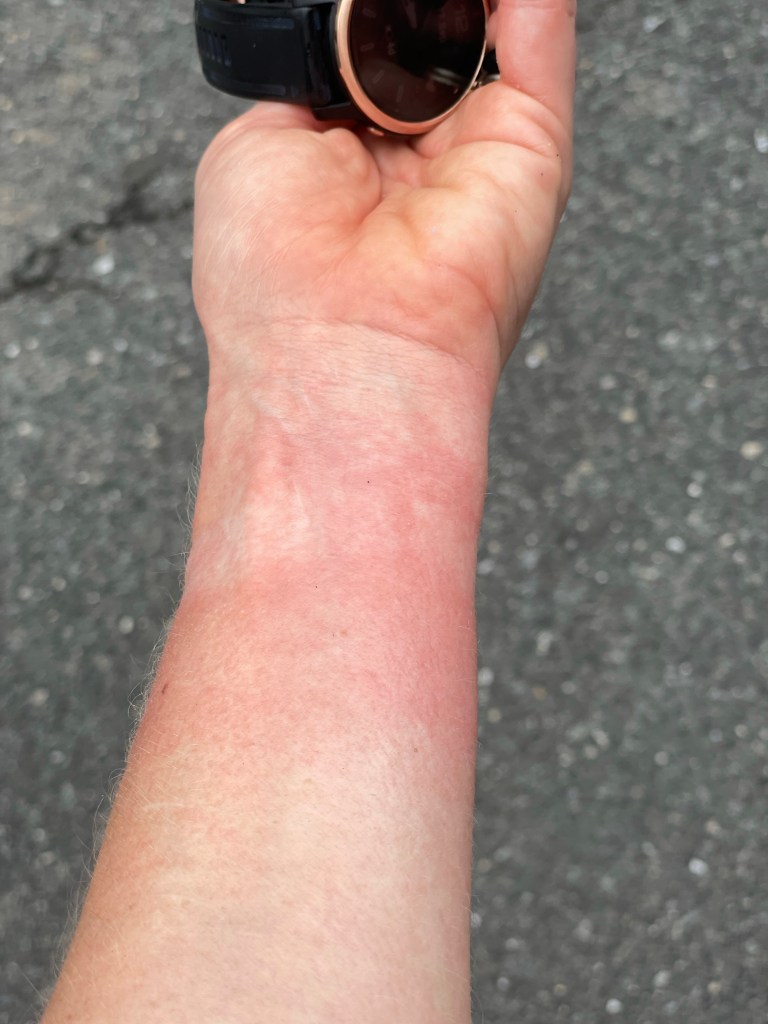
We walked back to our Air BNB and Randi was like, “you’re quiet. You’re never quiet.” She could tell how upset I was, and how little I wanted to get back in that water!
Instead of attending an early race briefing, we drove 20 minutes to get a bunch of supplies for T2. Many people told us that lidocain spray could help, as could claritin, so we wanted to load up. Randi and I got Aleve spray, lidocain gel, claritin, and claritin face wipes.
I’ve never been nervous before an Ironman swim, but I spent most of Friday worrying about how my body would react to swimming in Jellyfish for close to 2 hours, given that I felt so awful after 15 minutes.
Finally, after giving myself a bit of a pep talk, I came around to the idea that the actual swimming part wasn’t so bad. And even if there was a lot of stinging and itching after the swim, at least it couldn’t get any worse. Though I know Randi was nervous too, she didn’t complain at all!
Thankfully, the race director decided to make the race wetsuit legal, even though the water was technically too warm for people to swim in wetsuits. I’m glad that the need to protect athletes from the jellyfish outweighed the risk of people overheating!
Race Day
Randi and I were lucky enough to connect with Zack Goodman, another amazing triathlon guide (and soon to be ironman guide!) and his partner, B, who were able to give us a ride to transition in the morning.
Because we were in Cambridge alone, had Zack not offered to help, we would have had to walk 0.7 miles carrying bags with all of our food and water bottles. We’re eternally grateful to Zack for adopting us! B was attempting to qualify for Kona, so it was an incredibly important day for her, as well.
We arrived early enough to set up Randi’s bike, drop additional food in our bike and run bags, and use the rest room. My coach, Brad Williams, gave us an awesome tip. Because it was going to be so hot, he suggested that we stuff ice in our wetsuits to make sure we didn’t overheat before the swim.
Before we got to transition, I asked Randi if she was nervous. She said that she felt like she might throw up, which is exactly how you should feel before a big event! Race morning nerves are the real deal.
The final thing to do before wading into jellyfish invested waters was donning our wetsuits and applying a shit ton (that’s an actual unit of measurement) of vaseline and sea safe. I wanted every inch of exposed skin to be covered in two coats of goo.
I didn’t care how it looked – I just didn’t want to get stung.

Swim
Finally, Randi and I walked towards the starting chute. As in most ironman events, physically challenged athletes got to start first. We moved through dozens of people to get to the front of the swim start line. At this point, I started focusing more on the actual race, rather than worrying about the jellyfish. I’d been looking forward to doing this race with Randi for two years. I remember feeling overwhelmed with gratitude for the ability to even start the race.
When we got to the swim start, the announcer let us know that they were delaying the start by 5 minutes because it was too dark out. I was glad to have a little extra time before diving into jellyfish infested waters.
Randi and I said hi to a couple of the fast swimmers around us, and let them know that we’d be tethered together. Most of the athletes seemed to be familiar with the concept of blind athletes/guides, which was phenomenal!
After the national anthem, the official let us know that it was time to start. Randi and I waded into the water with the other blind athlete/guide team (Kathy and Jenny). We were strictly focused on our own race, especially because we knew that Kathy would swim much faster than Randi. In the weeks leading up to the race, Randi indicated that she was most nervous about the swim. Pools had been closed for months, and it cost Randi $20 round trip in an Uber to get to the gym, so understandably, her training had been spotty. Then throw jellyfish into the mix!
The anticipation of a race start is always worse than the start itself. Once we were given the all-clear, we began to walk into the muddy water. It remained shallow for a while, so we walked until we were at least waist deep. For anyone who’s worried about panicking in a swim, my advice is always to take it as easy as possible at the beginning. Keep your heart rate low, and swim like you’re taking a casual stroll. Once you’ve warmed up and proven to yourself that you won’t have a panic attack, you can pick up the pace.
That was Randi’s plan. Start slow, and then speed up. And she totally nailed it. Zero panicking, even with the anticipation of getting stung by jellyfish. Once Randi started swimming, she didn’t stop! It was amazing.
There was one small problem on my end. I’d done a terrible job getting vaseline off my hands, and my goggles were essentially opaque. I couldn’t see ANY of the buoys ahead of us. But my goal was to make sure I didn’t slow Randi down, or disrupt her at all, so I tried to problem solve on the fly. I ended up just taking my goggles off every few minutes to make sure we were on the right course. I was able to do it fast enough that I don’t think I disrupted Randi at any point.
Back to the jellyfish… They came out in force. Thankfully, they weren’t as relentless as they were in the practice swim. We got stung every 15 strokes instead of every stroke. At least that’s how it felt. I got stung on my ears, my lips, my ankles. One wrapped itself around my wrist. By some miracle, I didn’t find myself too distracted. They were just another obstacle in an already challenging race.
Randi finished the first loop of the two loop course in a great time! I let her know that she would break two hours in the swim, if she kept it up. The other swimmers were generally pretty respectful of us. I only had to grab a few people by the wetsuit to keep them from swimming between us. For anyone who’s not aware, when I’m guiding the swim, Randi and I are tethered by a bungee cord, so I try my hardest to keep people from getting clotheslined on the tether. At one point, I remember grabbing a woman and shouting “NO!” as she tried to go between us.
Just after the second to last turn, Randi seemed to be struggling. She popped her head out of the water and said, “my legs are cramping. both of them.” Leg cramps are the WORST. They can stop you dead in your tracks. I tried rubbing her legs while treading water, but it wasn’t helping. A kayaker came over so Randi could grab on while she stretched her legs against me. Nothing was helping! Eventually, a medical boat drove over to take her number. I asked if she wanted to call it a day, knowing what her answer would be.
Randi couldn’t kick at all. I said, “You’ve got plenty of time to finish this swim, but we have to keep moving. You need to dead leg the rest of this swim.” Randi is such a badass. She really is one of the toughest people I know. Because she had basically no other option, she just swam the last 1000+ yards without using her legs!
As we neared the finish chute, I noticed a guy standing on the pier using a net to fish jellyfish out of the water. I don’t know if it helped at all, but I certainly appreciated his efforts!
Randi was head down, just moving forward as fast as she could. I swam heads up and walked part of the last 10 yards, to make sure I was ready to keep her steady after she stopped swimming. After almost two hours in the water, it can be really hard to walk without getting dizzy.
I was so emotional after we finished the swim. Randi had set a PR in her swim leg, while facing leg cramps, too-warm water, and jellyfish. I was incredibly proud. I cried as we walked past the volunteers helping at swim exit. I actually looked forward to the rest of the race after that point!
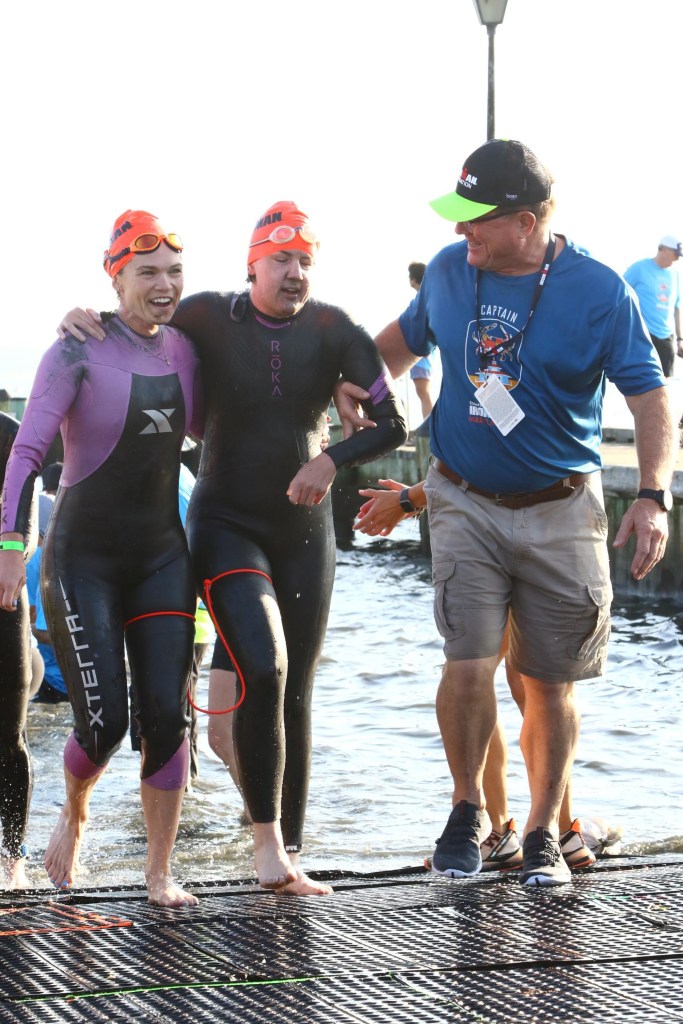
The water was dirty and disgusting, so I guided Randi to a hose and we washed our faces. Then I grabbed our T1 bags and headed to get ready for the bike.
Our first transition was long because we needed to spend extra time wiping off the vaseline and applying lidocaine/aleve spray to our stings. There were even volunteers at the swim exit with spray bottles of lidocain, to give you an idea of how bad the jellyfish were expected to be.
Randi and I shoved as much food into our jerseys as we could and ran to get her tandem.
We passed by Cheyenne, who was in town supporting Kathy and Jenny. Kathy is deaf/blind and Cheyenne knows sign language, so her presence was essential. She also graciously offered to help support me and Randi. It was amazing to see her cheering, given that we didn’t have any spectators at the race!
Bike
The bike is always my favorite part of the ironman. As a guide, it’s the part where my fitness matters most. I also bike raced for many years and have done several long bike races, so I feel most confident in my abilities as a cyclist. Also, Randi purchased a new custom tandem after our last Ironman, and it was amazing to ride.
I had stuffed the Aleve spray in the front of my jersey so that I could spray my jellyfish stings as often as needed. Randi seemed okay after T1, but I think I sprayed myself at least 10 times on the bike. I barely noticed my skin’s reaction after using it! I was thrilled!
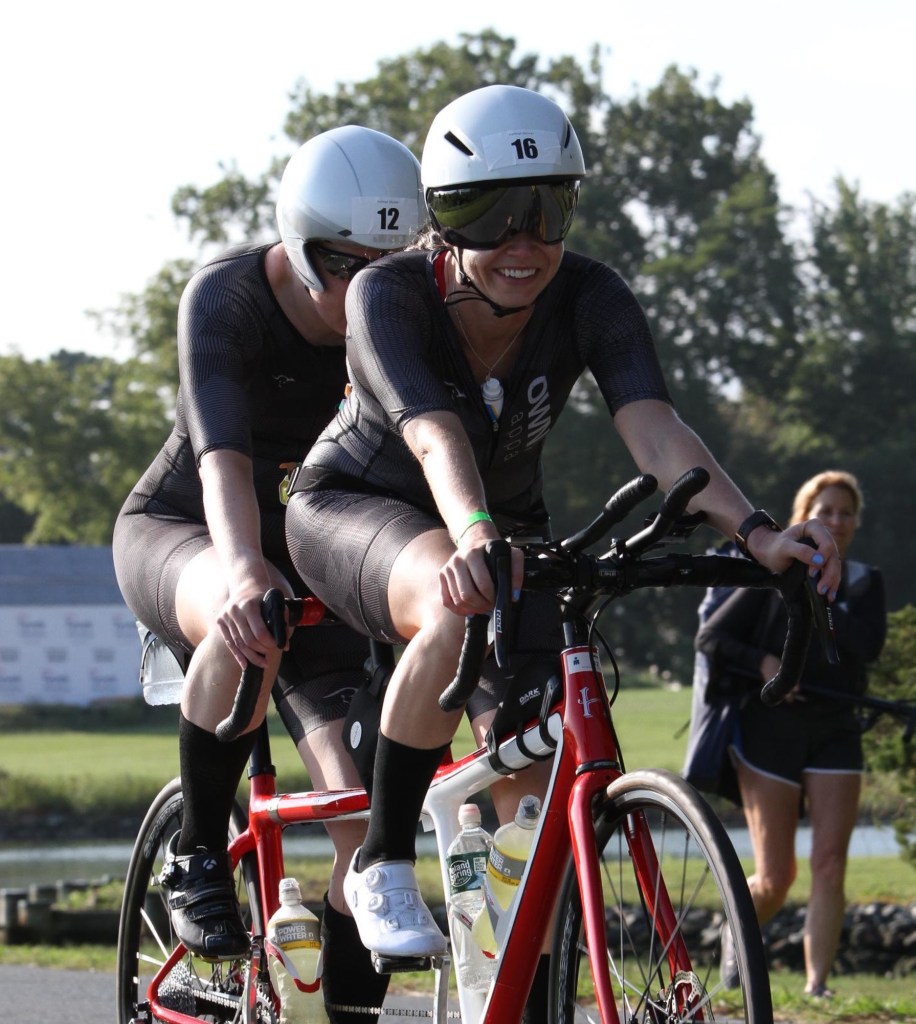
The first 10 miles or so were fairly slow. We had to wind through some neighborhoods and the roads were congested. There was an out and back section before we headed to looped part of the course. As we headed out towards the turnaround, I saw Kathy and Jenny on their tandem heading back the other way. Randi and I weren’t setting out to beat the other tandem team, but it was nice to have something to focus on. I figured that they were at least 30 minutes ahead of us, based on Kathy’s projected swim time. We had to make up some serious ground.
Around 25 miles in, we got to the two loop section. I checked in with Randi, who indicted that she was experiencing some GI distress. Even though she wasn’t feeling amazing, I didn’t notice any decrease in her power. We just needed to find a restroom at the next aid station. We stopped for a few minutes at mile 30 and then headed on our way. The Ironman Maryland bike course is FLAT. Randi and I specifically chose this race because it’s such a tandem friendly course. We also chose it because I expected it to be cool (boy was I wrong), but more on that later. The bike fit felt awesome, thank goodness. It’s always hard to tell how a tandem fit will hold up over a 6+ hour ride. There was no coasting on this course due to the lack of hills. Just straight pedaling for 112 miles. Randi’s bike has SRAM etap components and I usually ride shimano, so I joked with Randi that I’d figure out the shifting by half way through the ride.
Randi’s bike split when she did Ironman Texas was 6:24 on a slightly short course. We didn’t set a time goal because again, training had been difficult this year. But in the back of my head, I wondered if we could set a personal best for Randi.
The bike flew by. Literally and figuratively. Randi was cranking on the pedals. We both ate and drank consistently, and all of a sudden, we were on the second loop! I talked less than I normally do during the bike, just because we had such good momentum. I tried to stay in the aero position as much as possible because I knew we’d benefit from being as streamlined as possible. After we passed the half way mark, I was surprised that we hadn’t seen the other tandem yet, but that gave us another reason to keep working hard.

Randi still wasn’t feeling awesome, so when she asked if I’d broken into my Slim Jims, I felt terrible that she had to smell my pungent snack. Yes, I eat Slim Jims during Ironman bike rides. I’ve done it in at least 7 Ironmans. They work for me.
When we got to mile 70, I looked for another aid station for Randi. We really only needed to stop for bathroom breaks, because we carried all of our food with us, and we were able to grab bottles on the fly from volunteers. One of my proudest moments was in Ironman Texas when I grabbed four bottles (passing two back to Randi) during one aid station.
I tried doing some math to figure out what our bike finish time might be, but my brain wasn’t cooperating. I remember telling Randi, “we might PR, but we might not. It’s a possibility!” Super helpful for her, I’m sure.
All of a sudden, we were 90 miles in. I couldn’t believe it. I checked in with Randi. It sounded like she was fading a little bit. Totally understandable to feel like you’re fading, 90 miles into a bike ride! I also knew that even though she wasn’t feeling phenomenal, she was still riding really well. I can always tell when a stoker’s power drops off, and Randi’s output never fell.
I decided to play a game to help pass the time and keep us focused on moving forward, so I started (quietly) counting the people we passed. I would say the number out loud as we passed people, because I figured Randi probably couldn’t tell exactly when we were passing riders. 1, 2, 3, 4, 10, 15, 20… We were flying.
Between mile 90 and 100 we passed FORTY PEOPLE. I couldn’t believe it. We probably rode a little harder than we should have, but damn, it was fun.
After mile 100, we felt like we were on the home stretch. It was starting to get hot and we were both tired, but I kept counting. Between mile 90 and mile 112, we passed 69 cyclists. It was one of the coolest finishes of an ironman ride that I can remember. I was elated as we rolled into transition. I expected to see Kathy’s bike on the rack, because I thought we hadn’t passed them, but it wasn’t there. I figured we must have caught them at an aid station and not noticed.
I looked at my watch and realized that Randi had set a personal record on her bike split! 6:21 for 112 miles. Truly unbelievable!!
We racked the bike and headed to grab our run bags.
Run
It was hot out. It’s easy to ignore heat when you’re riding, but once we got off the bike, I realized how bad it was. I think it was at least 85 degrees out, with 98% humidity. The conditions were NOT ideal for the marathon portion of our race. I knew Randi was in the pain cave. She said she wanted to walk for a while.
I was just fucking stoked about how the bike had gone. At this point, I knew we would finish the race. The question was, would Randi set a PR. I didn’t care one bit if she did. The only thing I wanted was for Randi to be proud of her effort and her race.
The Ironman Maryland run course is a flat, 3+ loop course, with little shade. The amazing thing is that spectators are all over the course. It’s wonderful to feel so supported during the run portion. Shortly after we exited T2 we saw Zack Goodman again. He let us know that B was doing really well! Man, it felt good to see a familiar face.
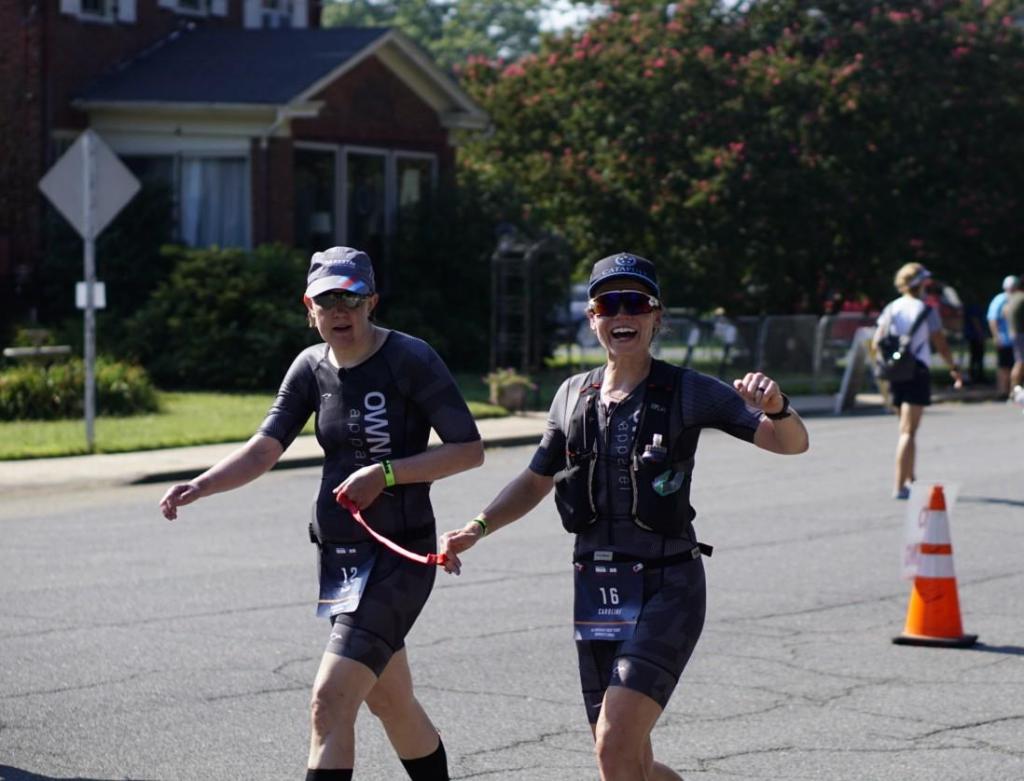
At the beginning of any ironman run, it basically feels like the race will never actually end. Remember, we had already been exercising for over 8 hours at this point.
To be clear, basically everyone looked awful on the run. It was incredibly hot. At least half of the people were walking as we passed. I tried to relay as much of that information as possible so that Randi knew she wasn’t alone.
Originally, Randi and I planned to employ a 4 minute run, 2 minute walk strategy. Early on, it was clear that we had to create a new plan due to the heat. About 3 miles into the run, we saw Kathy and Jenny running on the other side of the course. They looked really strong, so I was pretty sure they’d catch up to us soon.
One of the coolest parts of the early part of the run was encountering people who were signing at us. Several deaf people were out cheering Kathy on, and must have assumed that Randi was deaf/blind. It was wonderful to see so many people supporting Kathy!
Around mile 6, Randi seemed pretty unhappy. She asked me, “Is it normal to spontaneously cry during an Ironman?” I was like, “100% normal.” It basically means you’re doing it right!
Shortly after that, we passed a woman running on the opposite side of the road who was actually crying! She told a supporter that she was just throwing herself a pity party. Talk about validation!
Tons of houses on the course had signs in their yards in support of ironman athletes. Some kind families were out on the course with hoses and sprinklers to spray down overheating athletes. Randi wanted to run through sprinklers whenever we encountered them. I was hot, but I was feeling good, so I didn’t want to get my shoes wet if I could avoid it. We’d run towards someone with a sprinkler attachment and I’d shout, “can you get her wet, but not me!?” Everyone obliged.
At one point, we heard an athlete shout at a guy with a hose, “SPRAY ME LIKE YOU MEAN IT!!” Since I have the sense of humor of a 12 year old boy, I said to Randi, “That’s what she said.” That became an ongoing joke for the rest of the race.
Randi’s stomach started acting up again on the second loop. The pain was so bad, she was having trouble staying upright. Her strength and grit was astounding. We barely slowed down, though we weren’t able to run much.
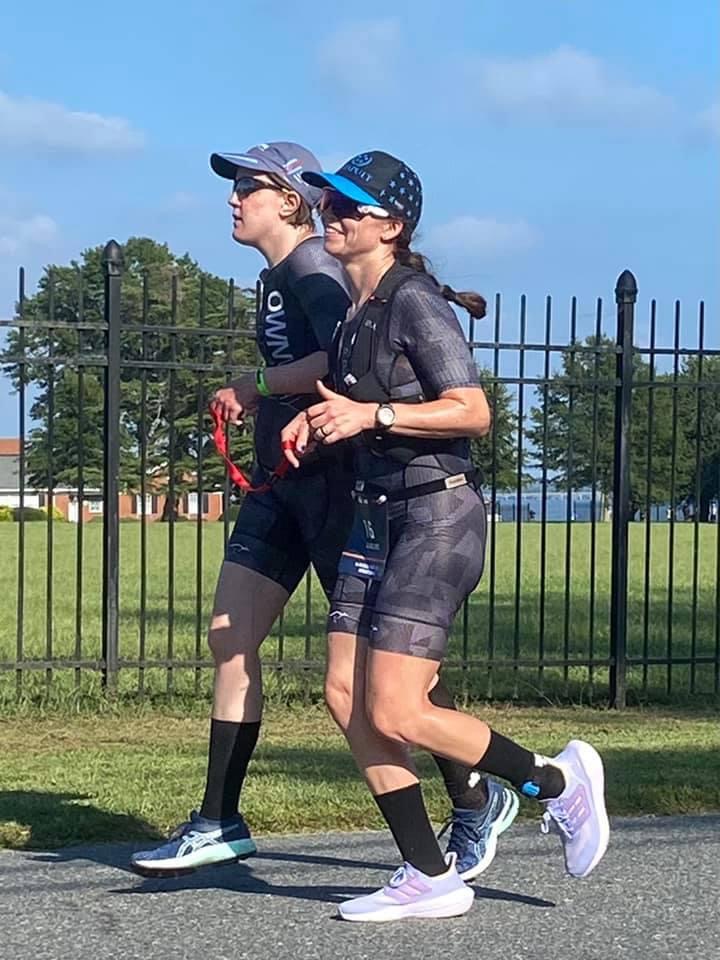
Each loop, we passed by our air bnb (what a tease!) and we’d see Cheyenne who would scream her head off for us! It was such a gift to see her each lap. We also saw Zack and his family several times. I forgot how important it is to have a support crew at an Ironman! At one point, Cheyenne even facetimed my husband and daughter so I could see them briefly during the run!!
Late in the second lap, we saw Jenny and Kathy again. They were about a mile behind us. I figured we would see them pass us at any moment.
To get through the rest of the run, we chatted with people on the course and made as many friends as possible. Randi’s stomach began to feel a bit better, but it didn’t cool down enough for us to pick up the pace meaningfully. I kept checking my watch to figure out what our finish time might be. It was still unclear as to whether Randi would beat her time from Texas.
On lap 3, Randi’s stomach started to feel a little better. It was getting dark, which was helpful. In Texas, Randi pretty much decided to walk the run, especially after she knew she would finish the race. In Maryland, I felt like it might make sense to push the pace, even if it just meant walking faster. Every few minutes, I would ask Randi if she wanted to run. There’s a fine line between motivating and badgering someone. I certainly didn’t want to impose my own expectations on her.
Amazingly, despite the heat, her stomach issues, and the fatigue of having been racing for 14 hours, Randi was able to maintain short run intervals almost the entire final lap. On the final lap, we passed by the part of the course where we’d seen Jenny and Kathy on the prior two loops. It looked like we’d widened the gap. Randi said over and over that she didn’t care who finished first, but it was just a point of reference for us. Randi was maintaining an incredibly consistent pace!
She hit her final wall with about 2 miles to go. Randi said she had absolutely nothing left – she wanted to save her final run for the finish chute.
I realized that she was actually going to beat her Texas finish time!!! How was that even possible? Randi had limited training partners throughout the pandemic, she’d had a really tough summer, and this race was unbearably hot.
We rounded the final turn and headed into the brick paved straightaway towards the finish. Spectators still lined the course and people were cheering. I told Randi that I’d give her the all clear to run when we got onto the finishing carpet.
There’s absolutely nothing like finishing an Ironman. This was my 10th finish as a guide, but the excitement was just as great as the first race I’d ever done.
We ran across the line with a finish time of 15 hours, 43 minutes. Randi had beaten her best time by four minutes! It was an amazing achievement, but again, I would have been impressed by any finish, given how tough the day was.
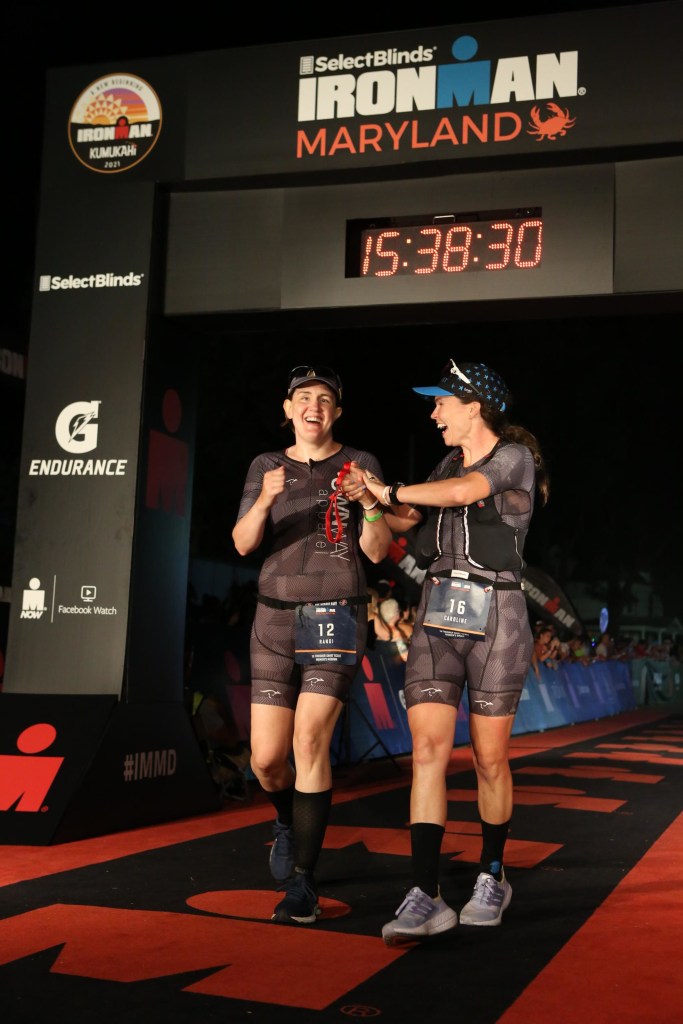
I was overcome with emotion after we crossed the line. Randi and I embraced and I just lost it. I started bawling and couldn’t let her go. I was proud of us both. We each gave as much as we could on the race course, and in the months leading up to the race. It was the culmination of a two year journey with one of my favorite people on earth. I enjoy Randi’s company so much, I could have turned right around and done the race again. Just kidding. I was pretty wrecked after that finish!
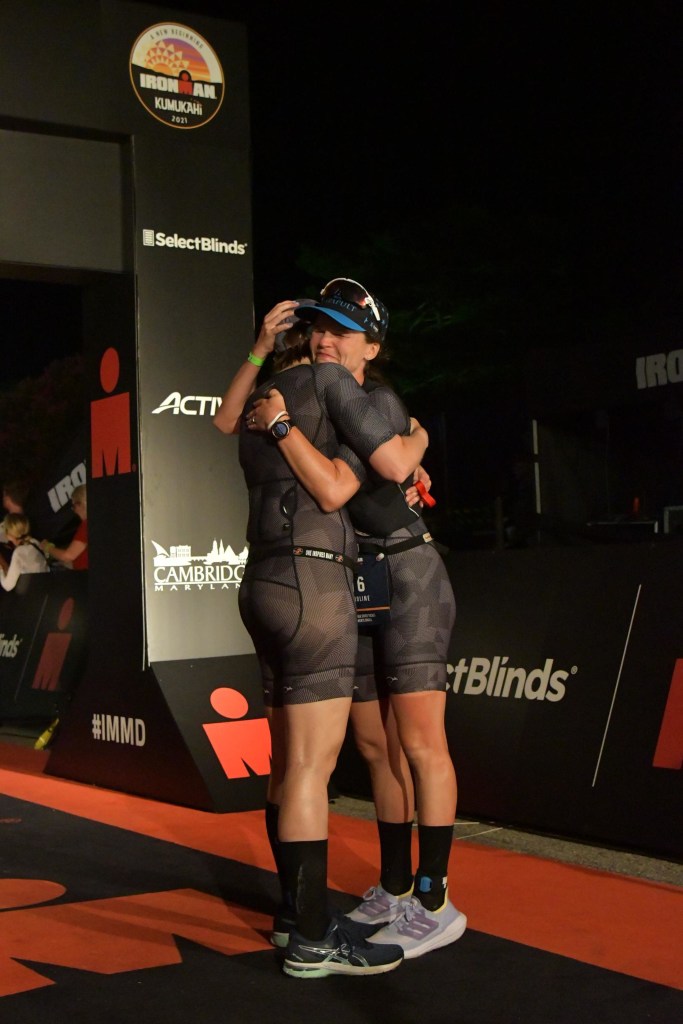
A note to Randi: Randi, you are so strong. You are such a phenomenal athlete. It was a joy to spend 5 days with you in Maryland and I’m honored that you choose to race with me. I’m in awe of your grit. Thank you for your friendship and your counsel. I love you more than I can put into words. Congratulations on finishing your second Ironman! I can’t wait for the next one.
Randi’s perspective:
Randi and I wrote our race reports separately, without checking in with one another. In case you want to read about the race from Randi’s point of view, I’ve copied her account below!
2021 Ironman Maryland Race Report
I signed up for this race with Caroline as my guide in 2019, and like most things it was canceled and we were deferred to 2021. A couple of months before the race I was dealing with some stressful life stuff and didn’t even know if I wanted to keep training, but in talking to Caroline she said she didn’t care if I trained perfectly or was under trained but that we should show up to the start line anyway. It meant the world to me to have her support and understanding. To be honest, it felt like the race snuck up on me. We had been anticipating it for two years, and all of a sudden I was packing my stuff and on a plane to Baltimore. I was able to spend Wednesday night with my dear friend Karen, who I hadn’t seen in person in over two years. It was a perfect and relaxing start to race week. Caroline managed to get us a perfectly located place to stay, just off of the run course and just 0.7 miles from the start line and an even sweeter 0.3 miles from the finish line. It was so nice to walk to swim practice and to get our bike, and did I mention the very short trip back after the race?
Just a few highlights prior to race day because I don’t want this to be too long. We debated about doing a practice swim because of all the chatter in the Ironman Maryland Facebook page around the jellyfish we decided it probably would be a good idea. Walking up to the practice swim it was all people were talking about, how many jellyfish there were. I had no idea what to expect so we lathered up with Sea Safe and Vaseline to supposedly create a barrier on our skin for the stings… spoiler alert, it did nothing. Swimming through these sea nettles was like swimming through grass, though it wasn’t long blades of grass you drug your hands through each stroke it was tentacles. The feel of them didn’t bother me, but the stings were not comfortable, particularly the ones on my face. They kind of felt like little tingles of electricity or bigger jolts when on my nose and lips. I’m glad we did the practice swim but I really didn’t want to get back in the next day. I am also glad we did the swim because in my last couple of open water sessions I had tended to panic a bit at the beginning. My heart rate rises and I can’t control my breathing. I hoped getting the practice out of the way would clear this for race day.
The rest of Friday included a trip to the pharmacy for sting relief options and hanging out with Zack and Beril for lunch. Zack is also a guide for blind athletes and a great triathlete himself and Beril is also super-fast, she raced her way to a Kona slot in this race and she’s a delightful human. It was so great to get to spend some time with them and to get to know them better. We then went and checked in our bike and dropped gear bags and came back to spend some time with Kathleen, a deaf-blind athlete racing and her guide Jenny, as well as Cheyenne who came as race support. It’s always awesome to share the race course with other blind athletes and their guides, and I love the supportive community we have in this sport. After some pasta and checking bags for the 27th time it was time to attempt sleep before race day.
Race morning it was so nice to be close to the start line, Zack picked us up and we made the quick drive over to the transition area. After a few last-minute details we headed down toward the swim start. Even though the effectiveness of our “jellyfish barriers” were questionable we lathered up any exposed skin with Sea Safe and Vaseline. The race officials had made the call to increase the temperature for wetsuit legal racing to 78 degrees instead of the usual 76.1 due to the jellyfish numbers. I think everyone was thankful for that. As usual the PC athletes started first which is great as we don’t have to hurry into the water, we were able to take our time and start slow and I was happy to have a smooth start without any issues. The first loop of the two-loop swim was pretty uneventful, other than the occasional person trying to swim between Caroline and me. It always makes me laugh a bit to think about those poor souls and the hand or foot to the face they must be getting from Caroline. As we started the second loop of the swim I noticed my legs starting to cramp a bit. I was able to really relax my legs and hold them off until around the halfway point of the second loop. Then both calves started cramping, I stopped Caroline and floated in the water trying to relax, but if I flexed my foot one way my calf would cramp, and flexing it the other way caused my shins to cramp. I started to freak out a bit and asked for a kayak. I had Caroline try to rub out my legs as I held on to the boat, it felt like we were there forever with no relief. They had a medical boat come over and check on me, but the cramps started to ease a bit so I said I’d try swimming again. I figured if it came to it, we would just find another boat. I was able to finish the swim by just dragging my legs behind and trying to relax them and not move. My swim training had not been great so I was so happy to have made it with plenty of time to spare, even with the stopping.
Transition was uneventful, but long trying to get all of the Vaseline off of our faces, but we headed out on the bike with no issues. I really enjoyed this bike course. The first 25 miles included an out and back section and then you got onto a 40 mile loop that we completed twice. I thought the two loops made the ride go by very quickly. I tried to stay on top of nutrition the whole time and thought it went well, though I was dealing with stomach issues almost immediately. My stomach would bother me throughout the day, and later I learned that stomach issues can be a side effect of jellyfish stings, and I learned after the race that many folks in the Facebook group were also dealing with similar issues. Mile 80 on the bike is always a huge mental hurdle for me, and we hit 80 in good time. In contrast, getting from mile 85 to 90 felt like it took 3 hours, so at mile 90 Caroline started counting the other cyclists as we passed them to distract me. We picked up the pace a bit and ended up passing 40 athletes between miles 90 and 100. We then kept the tally going and passed an additional 29 cyclists between mile 100 and the end of the bike at 112.
It started to feel hot on the second loop of the bike course, and the humidity had been in the 97 to 99% range while we were there so I was a bit concerned how I would handle that on the run course. We made it through transition and on to the run, but I was still dealing with stomach pain so we walked the first 3 miles of the course. I think around mile 2.5 I asked Caroline if it was normal to want to spontaneously cry. I was not in a good place physically or mentally. Her answer was a matter-of-fact, “yes, you’re doing an Ironman.” With her persistence we tried a run walk strategy, and even though we weren’t running much, when we did it certainly made time go by more quickly. Nobody on the run course looked comfortable in those conditions, even the leaders looked uncomfortable. Ironman is a humbling and wonderful sport. We saw so many folks walking the course. I can get down on myself, thinking it’s just me, but we ran into plenty of people who had great training coming into the race who were having a tough go of it as well. I don’t think we talked to anyone on the run course who said they were having a great day. Thankfully as the sun went down it got cooler. We continued to run some and walk a lot. I really love the community feel of the back half of the run course late in the evening. Would I rather be running, sure, but we did meet some fun people as usual. We kept seeing a guy named Aaron, and we would cheer for each other on the course. We walked and talked with Harrison who runs a non-profit for veterans, and Ross a CrossFit athlete who got into running over the pandemic and decided to do an Ironman, he also had a great mustache. Little interactions like that keep me going.
The volunteers and spectators on the run course were next level all night as well. The town of Cambridge is so supportive of this event and it’s really fun to see. We also kept seeing Kathleen and Jenny on the course which was great. A huge thank you to Zack and Cheyenne for some awesome run course photos and videos as well. The run course was three loops. Making it to the last loop is always a great feeling, you know that you never have to pass markers on the course again. Caroline continued to encourage bits of running which I appreciate, even if not in the moment. I was done the last 3 or 4 miles of the course, and here is where racing with a guide is great, she is a constant support on the course and I can’t express how much I appreciate that. I was definitely losing it a bit at the end and she motivated me to keep going. For a good portion of the run course you can hear the finish line, and finally it was our turn to run the red carpet. I was so glad to be done, and also very proud of a hard fought day. Finish line hugs are the best hugs, and I feel so lucky that I have a great friend who loves to suffer through these races with me!! I ended up with a PR on the day, and was faster in all three disciplines in Maryland than in Texas in 2018. I dug as deep as I could in this one both physically and mentally. I’m proud of pushing through the jellyfish and cramps on the swim, and for continuing forward momentum throughout the run in very tough conditions. Time to relax for a few weeks and start training for the next one. Ironman Alaska 2022.
***I am not guiding Randi in Alaska, but I know we’ll do another race together soon!



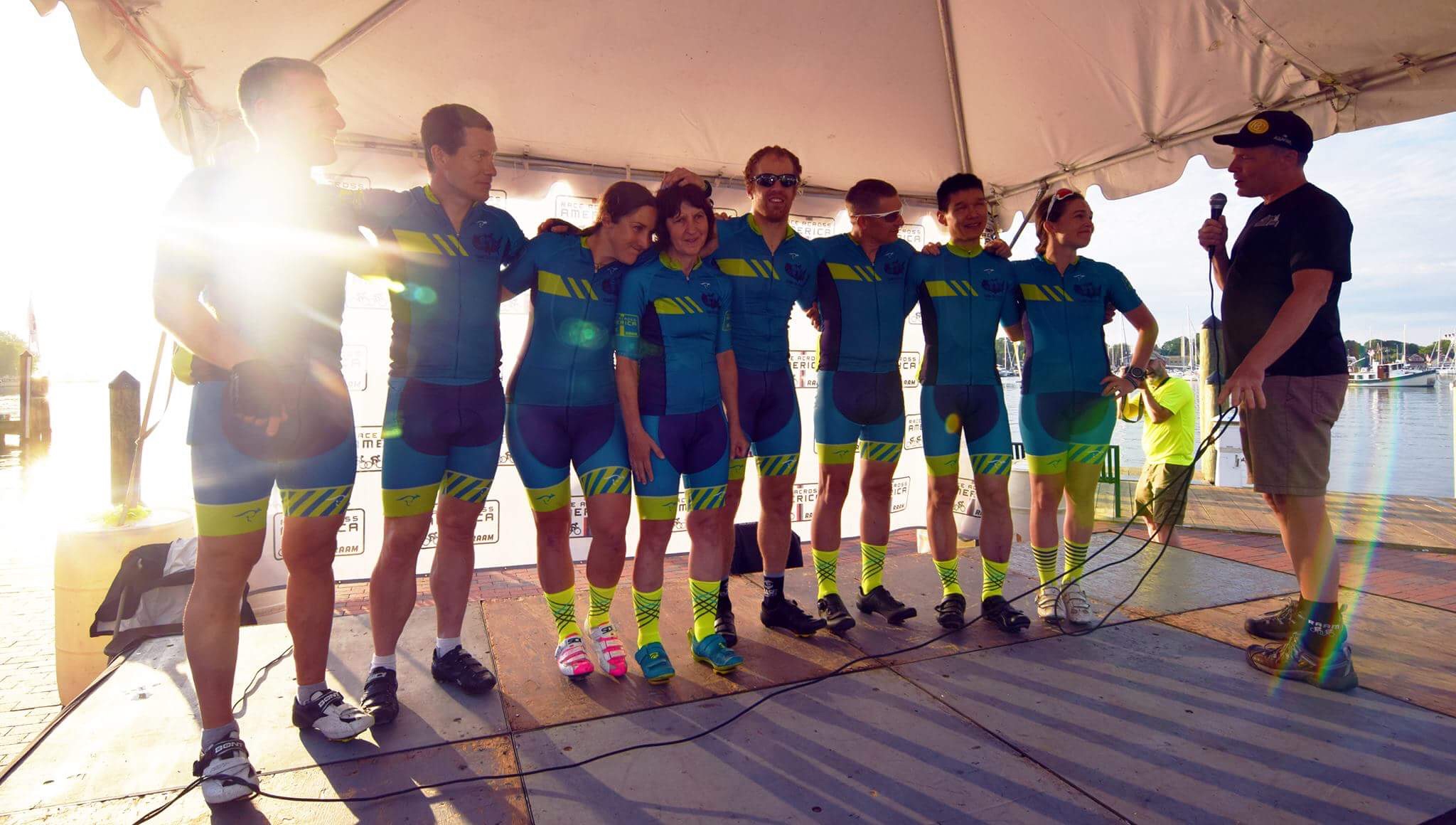


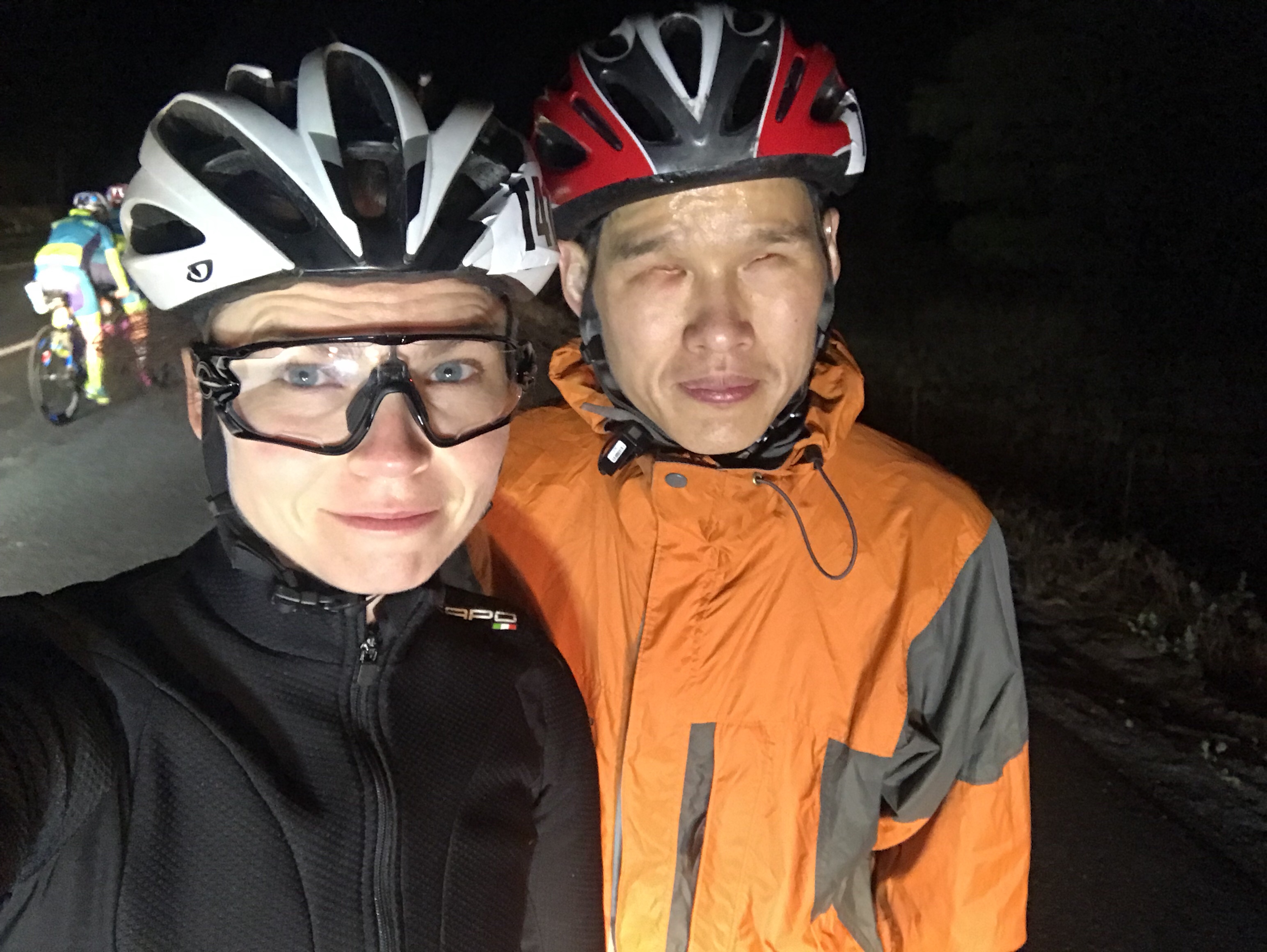




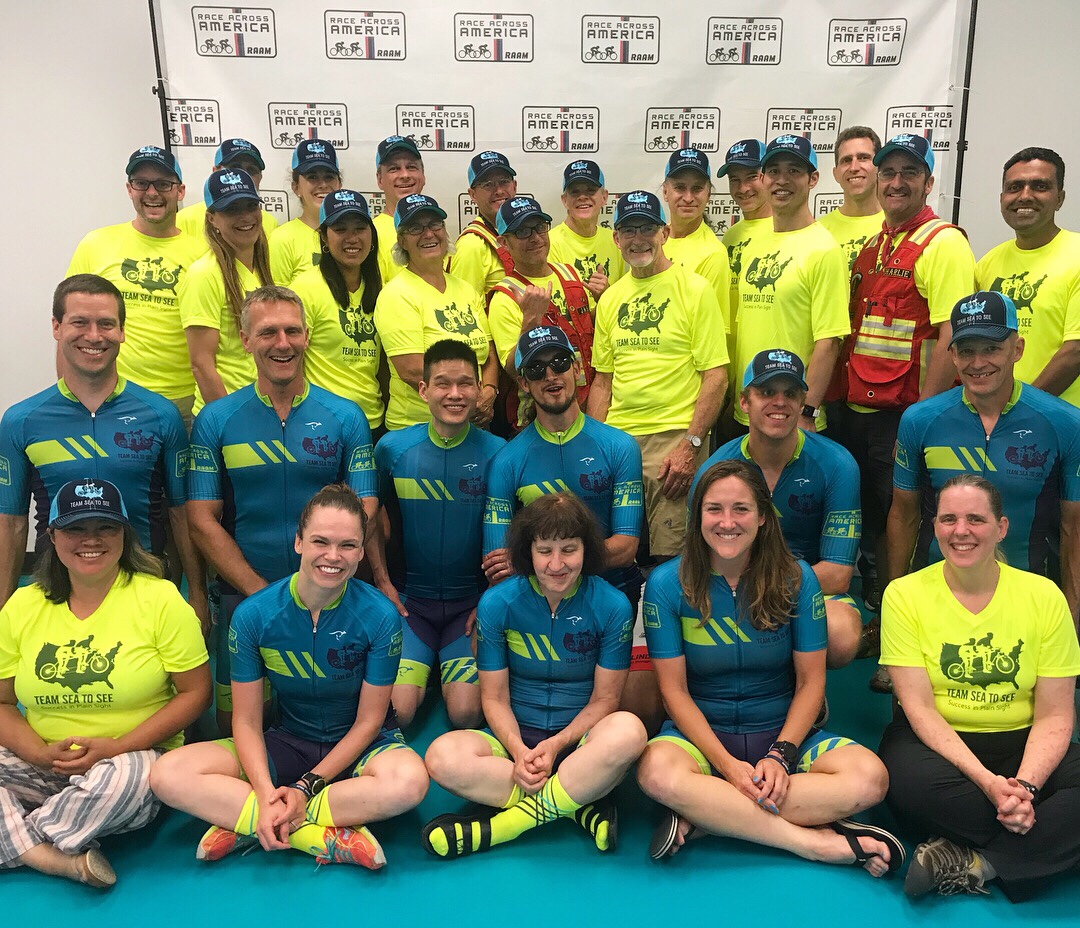


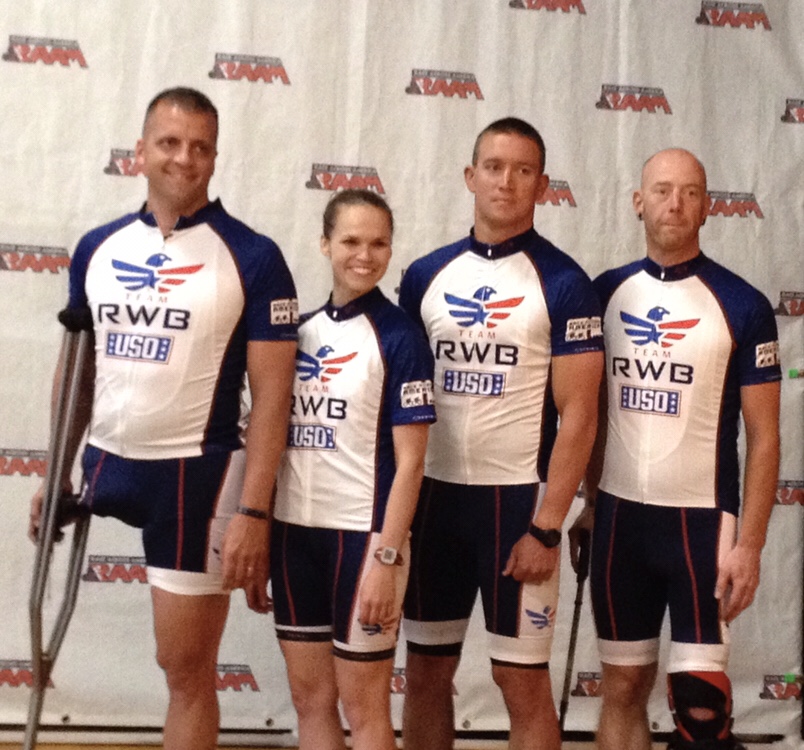
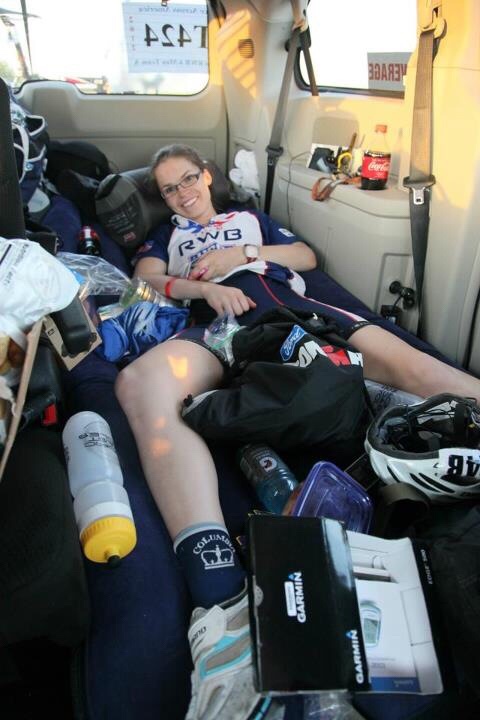
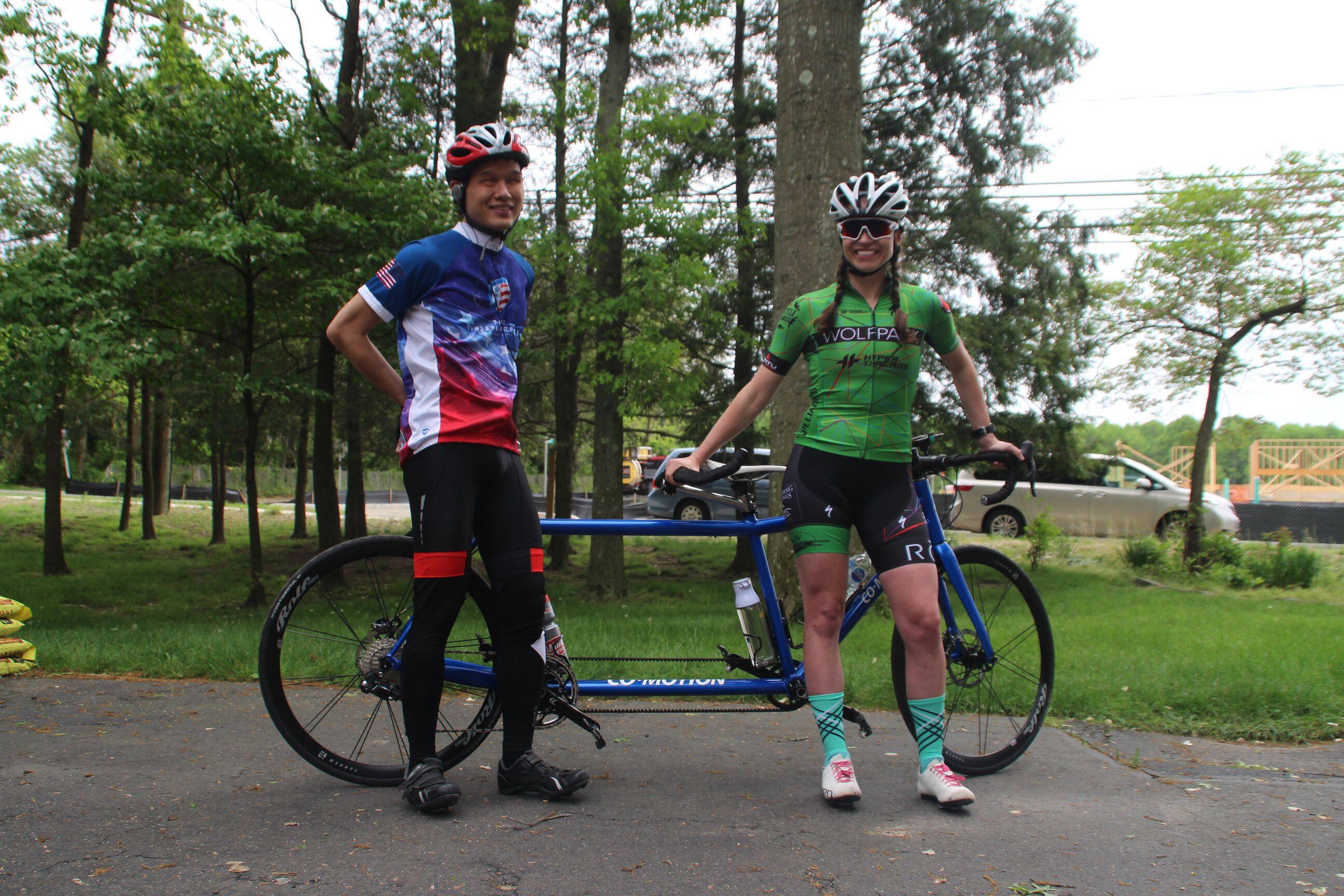

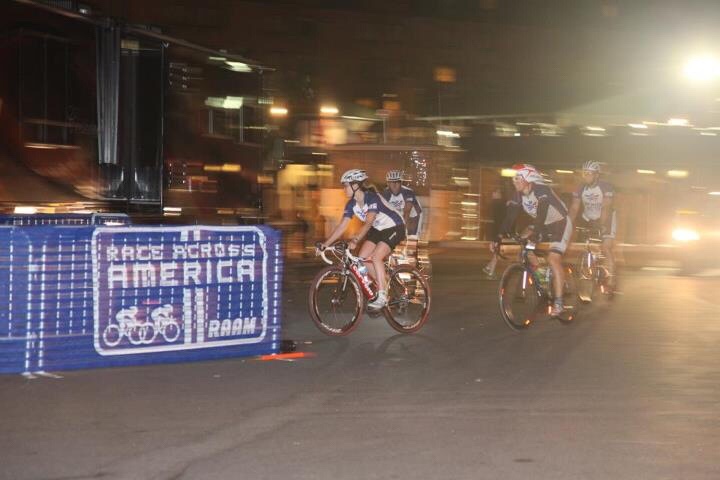
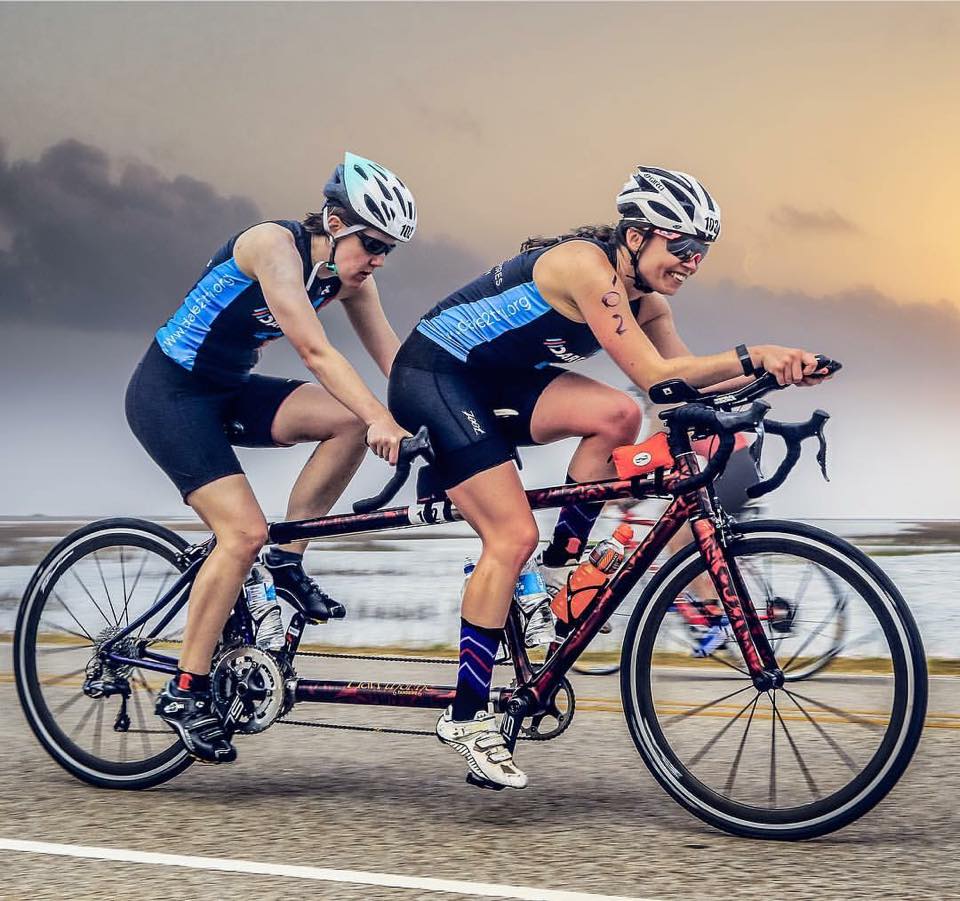

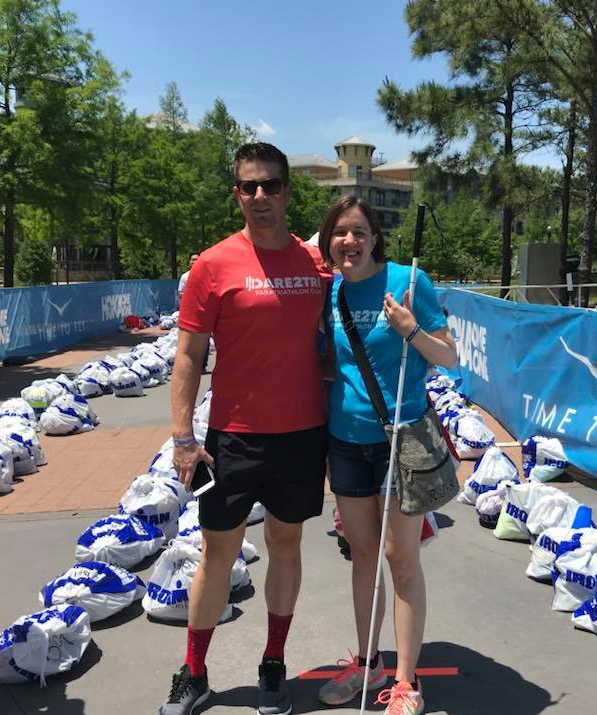


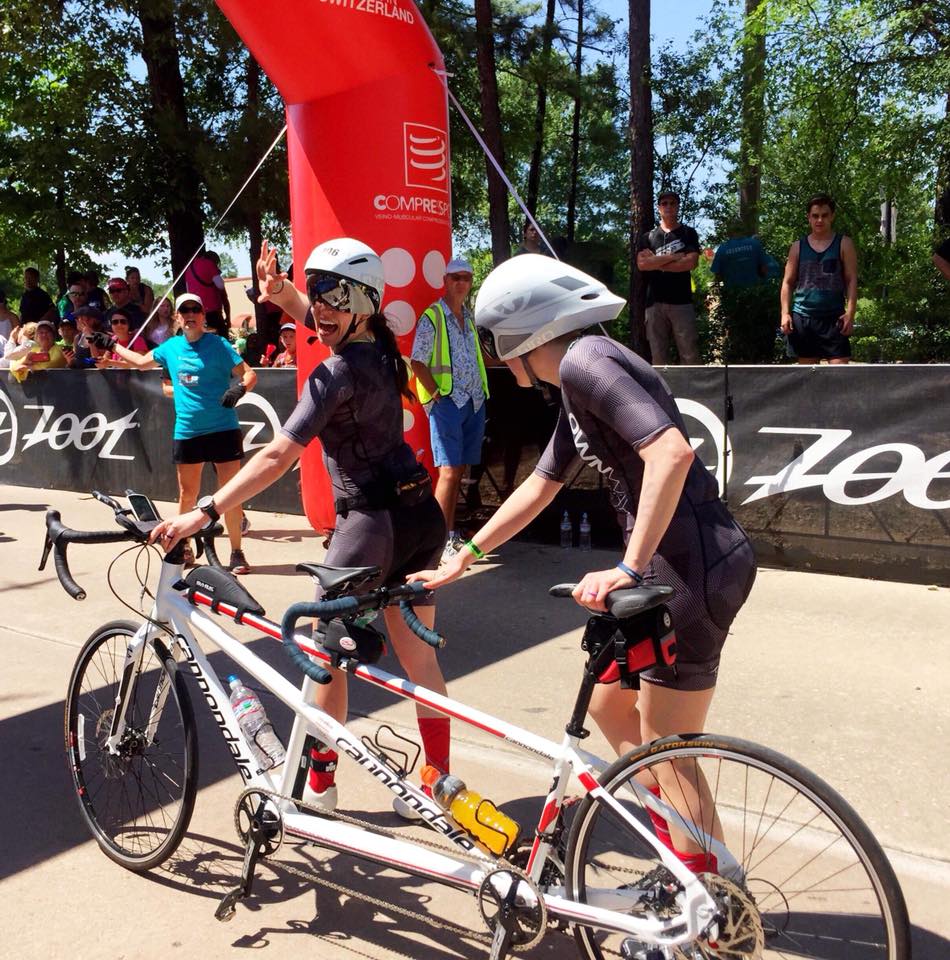

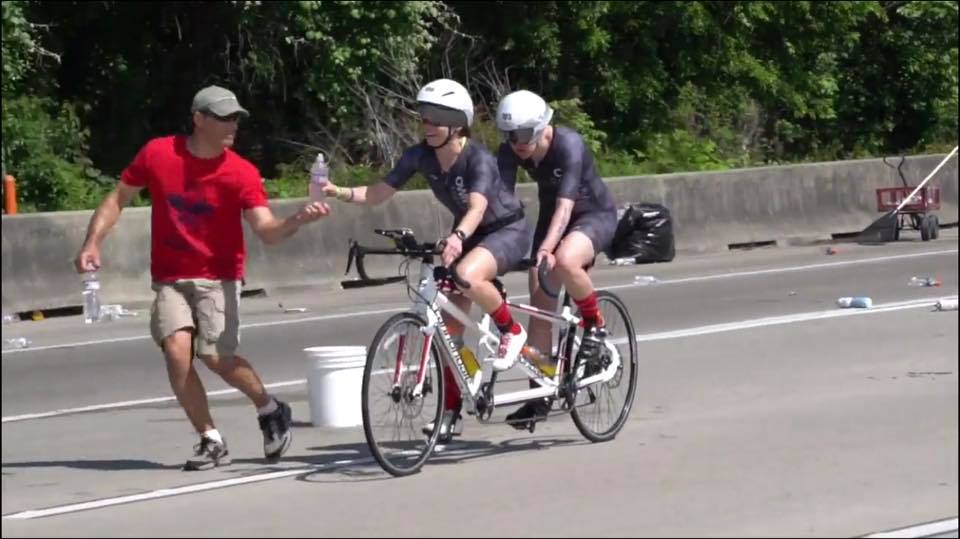

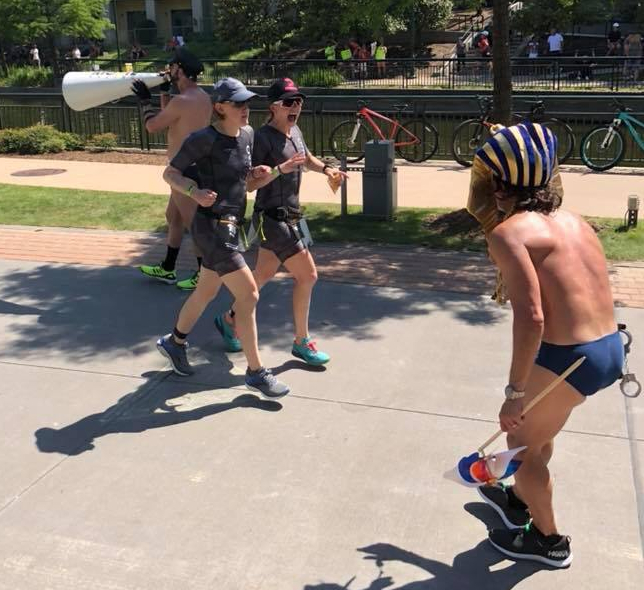
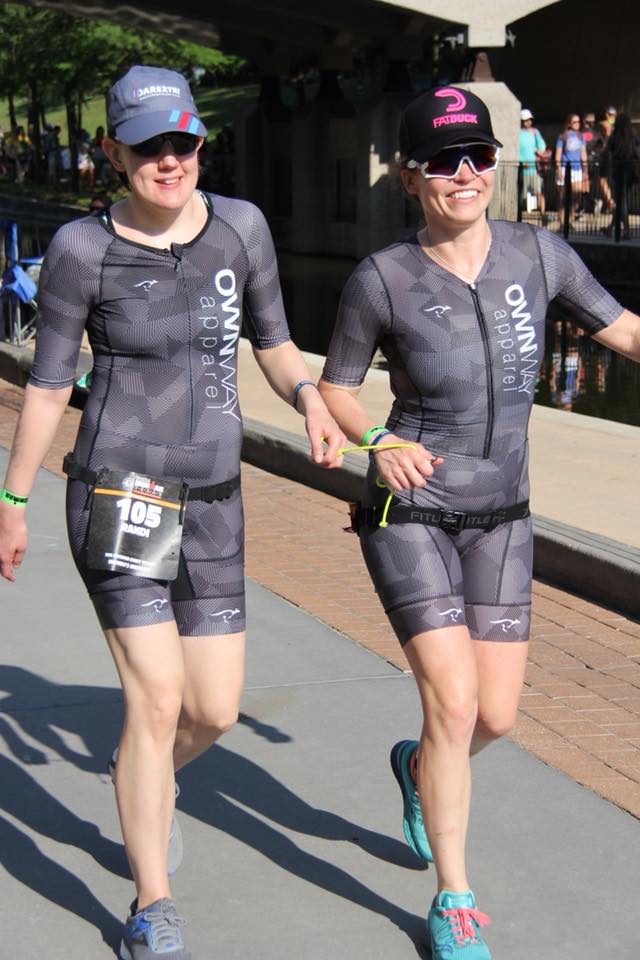


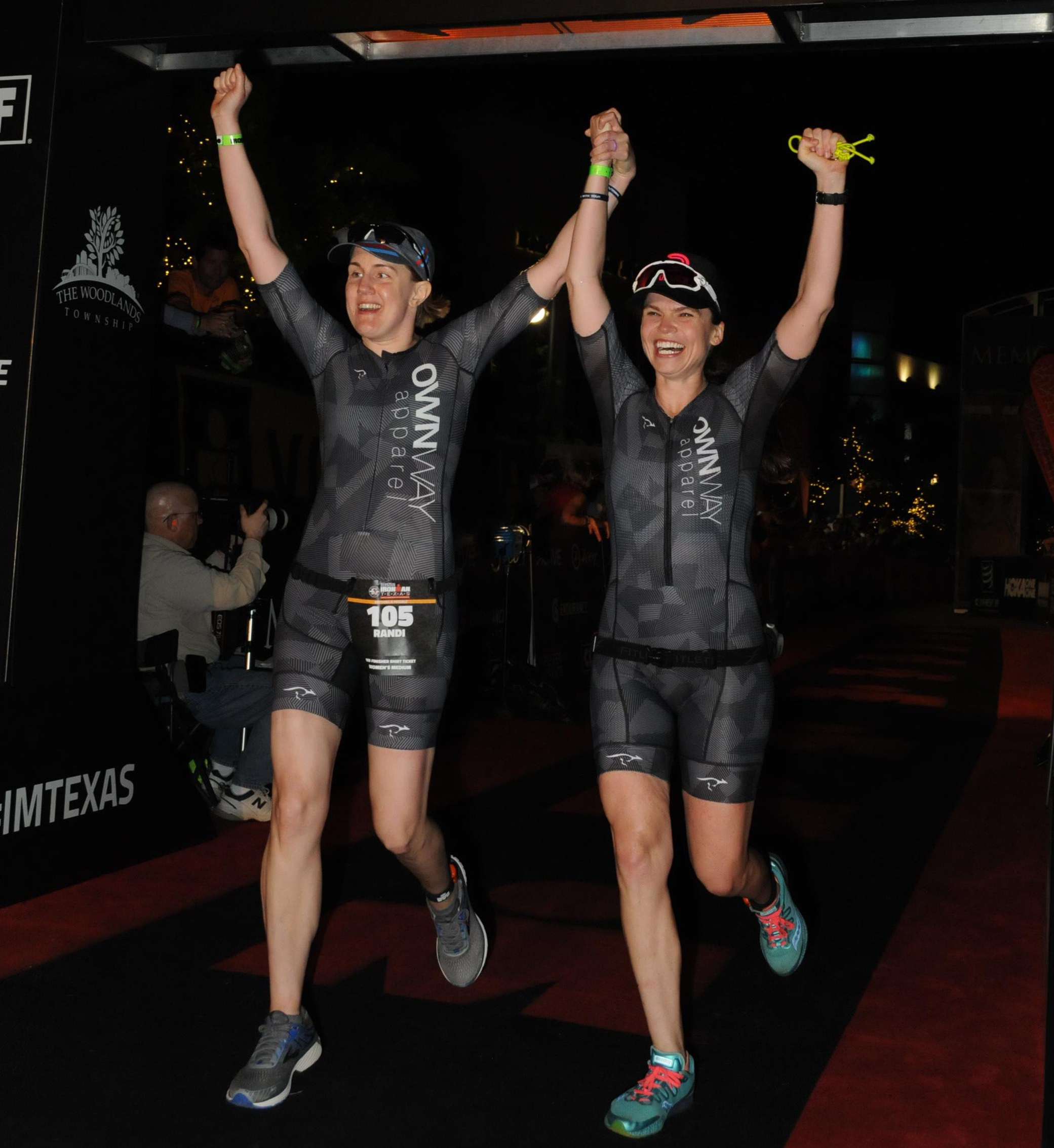



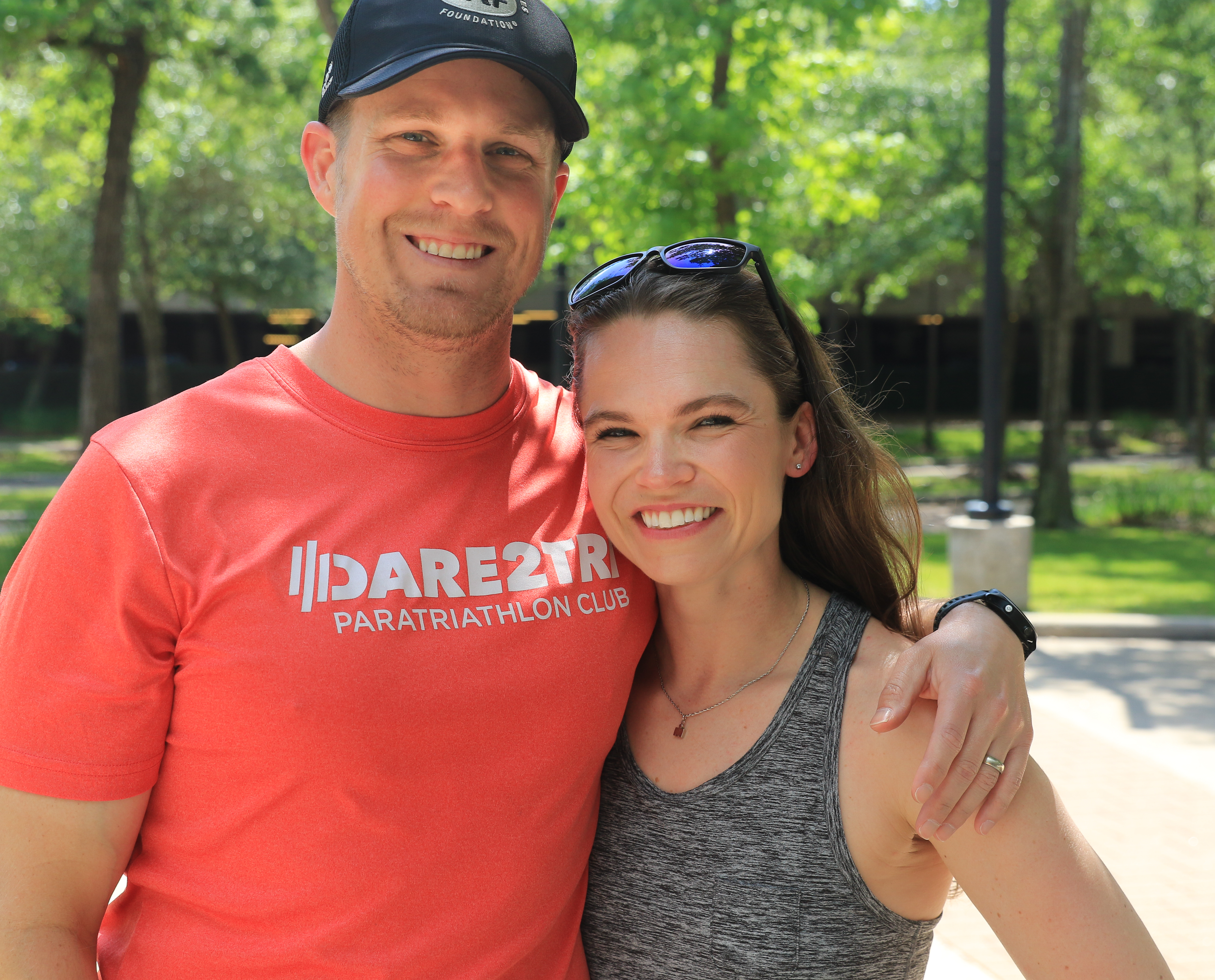
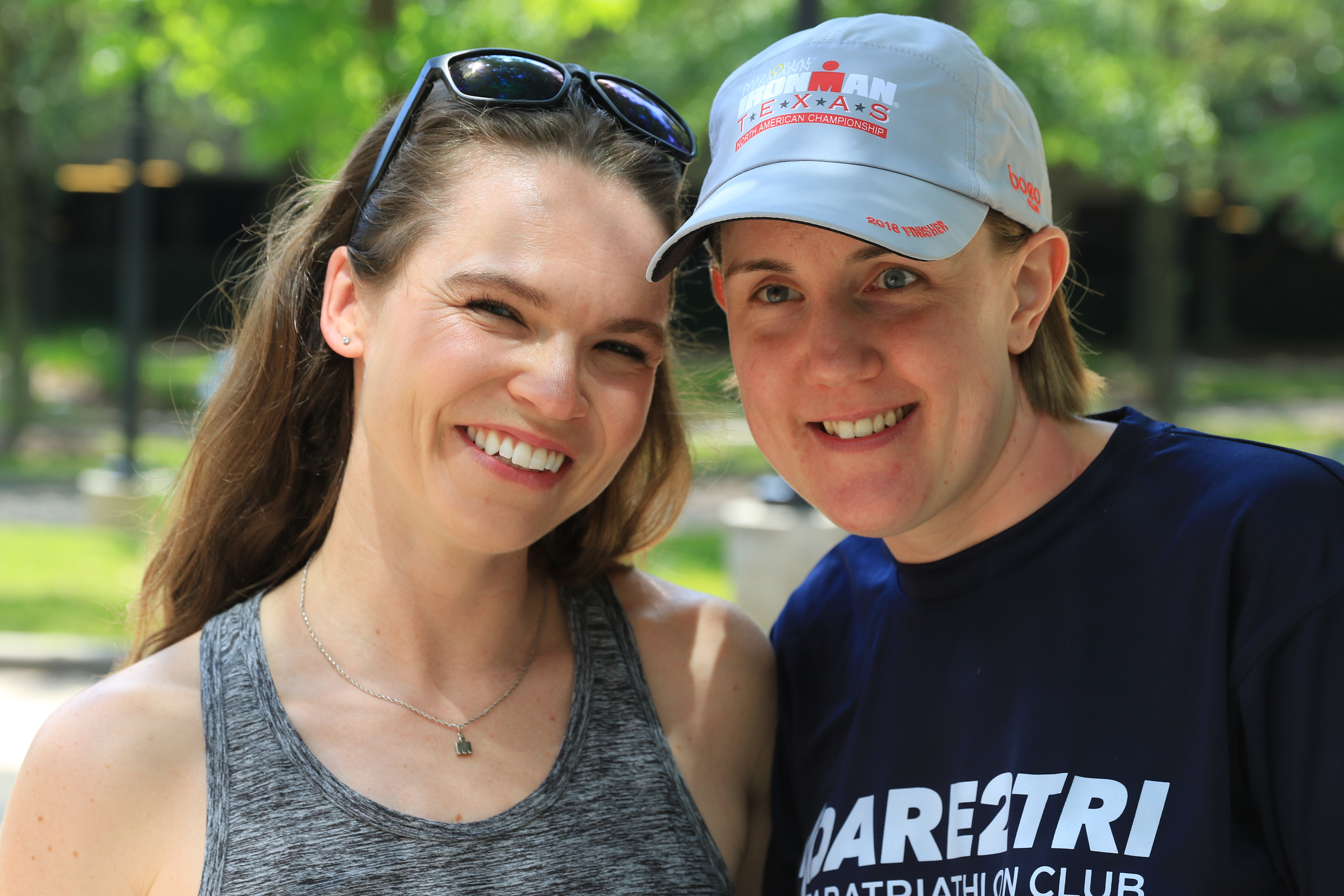


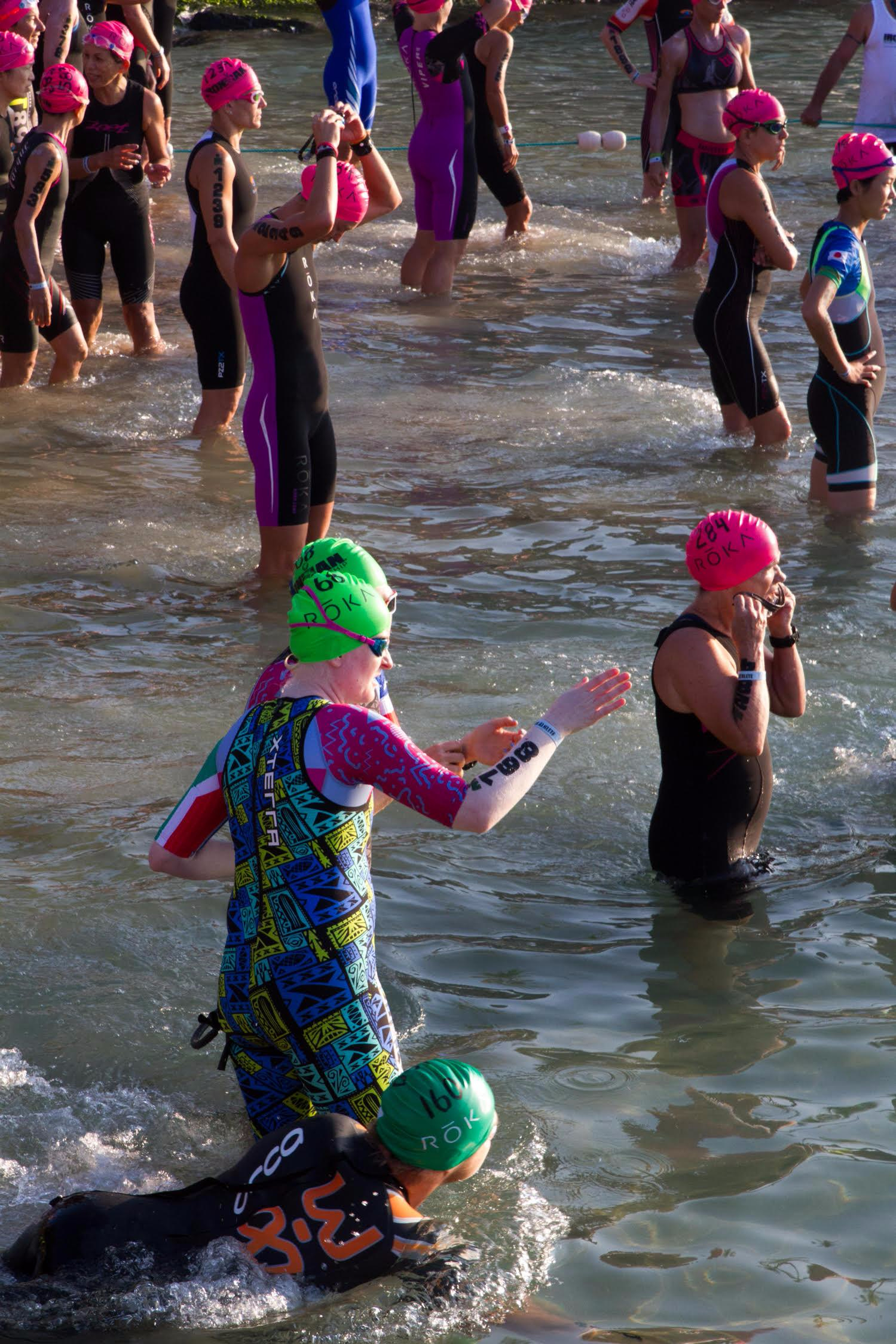

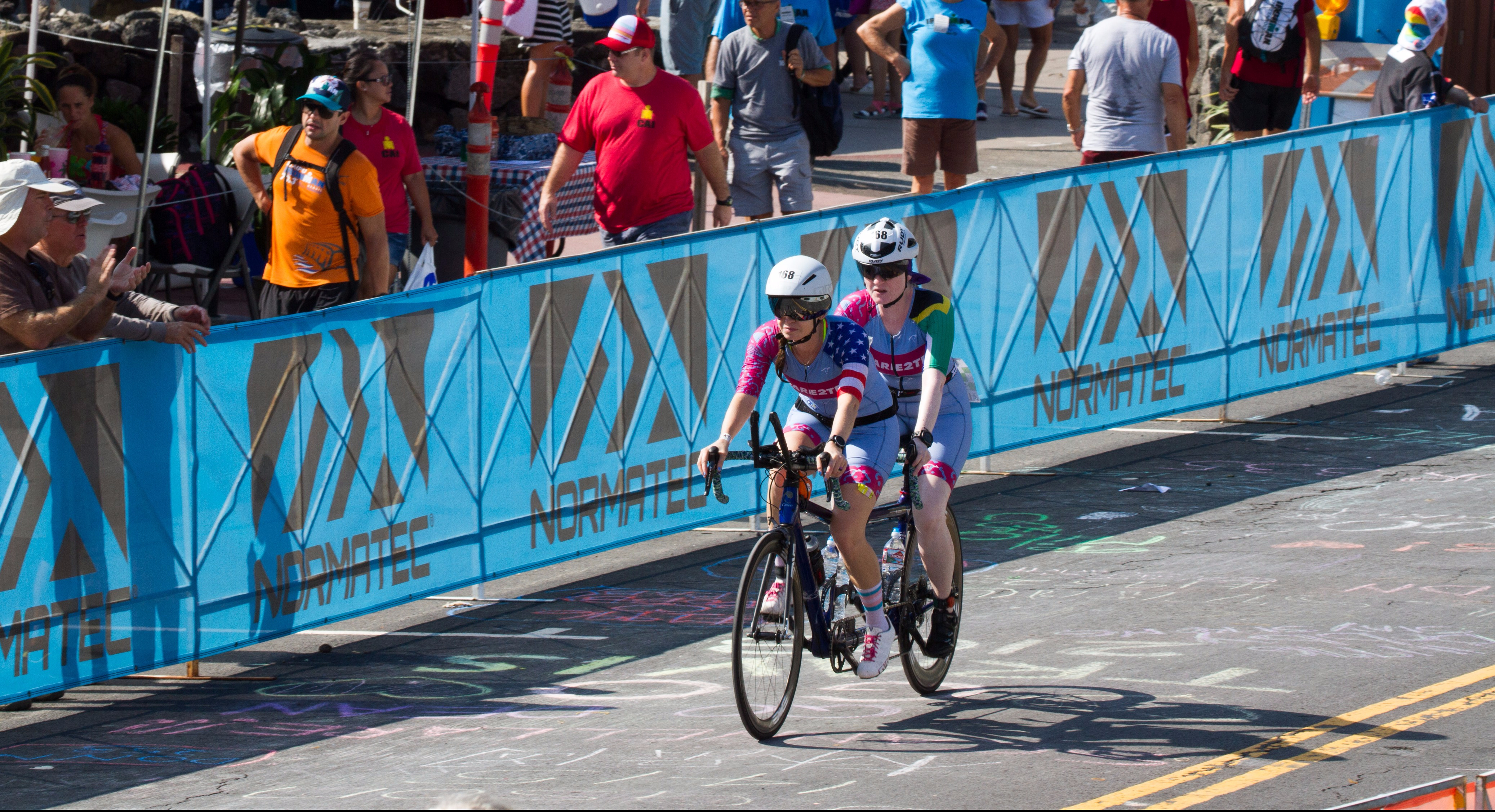
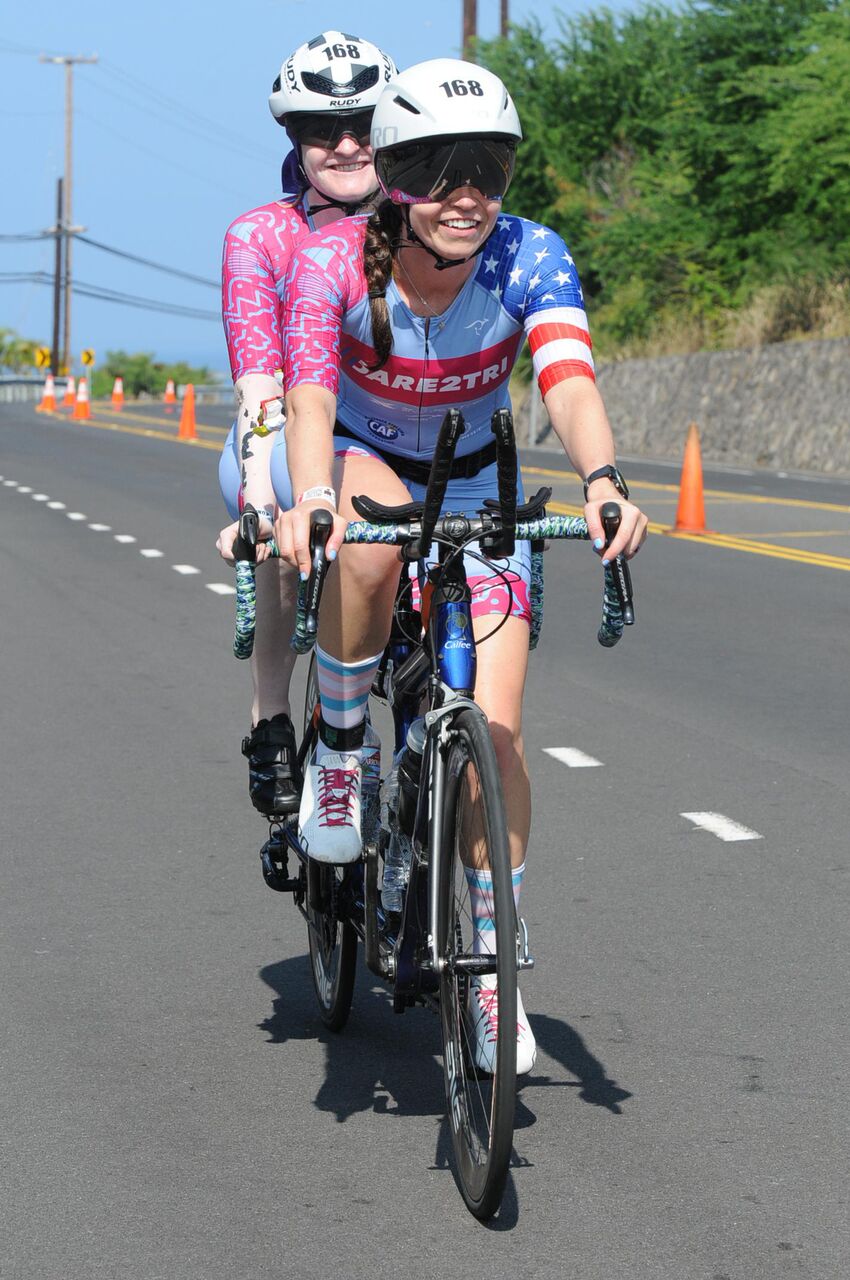


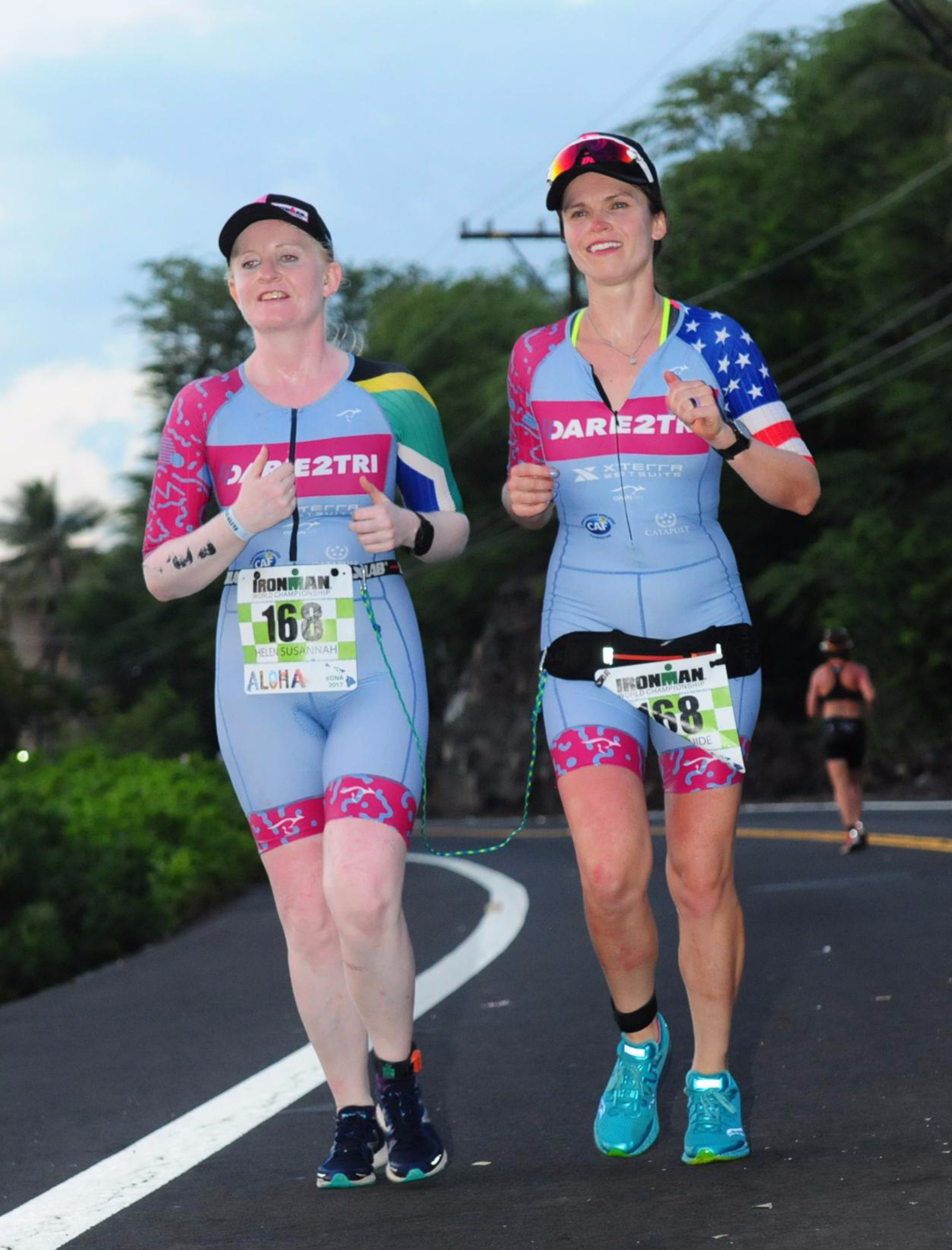

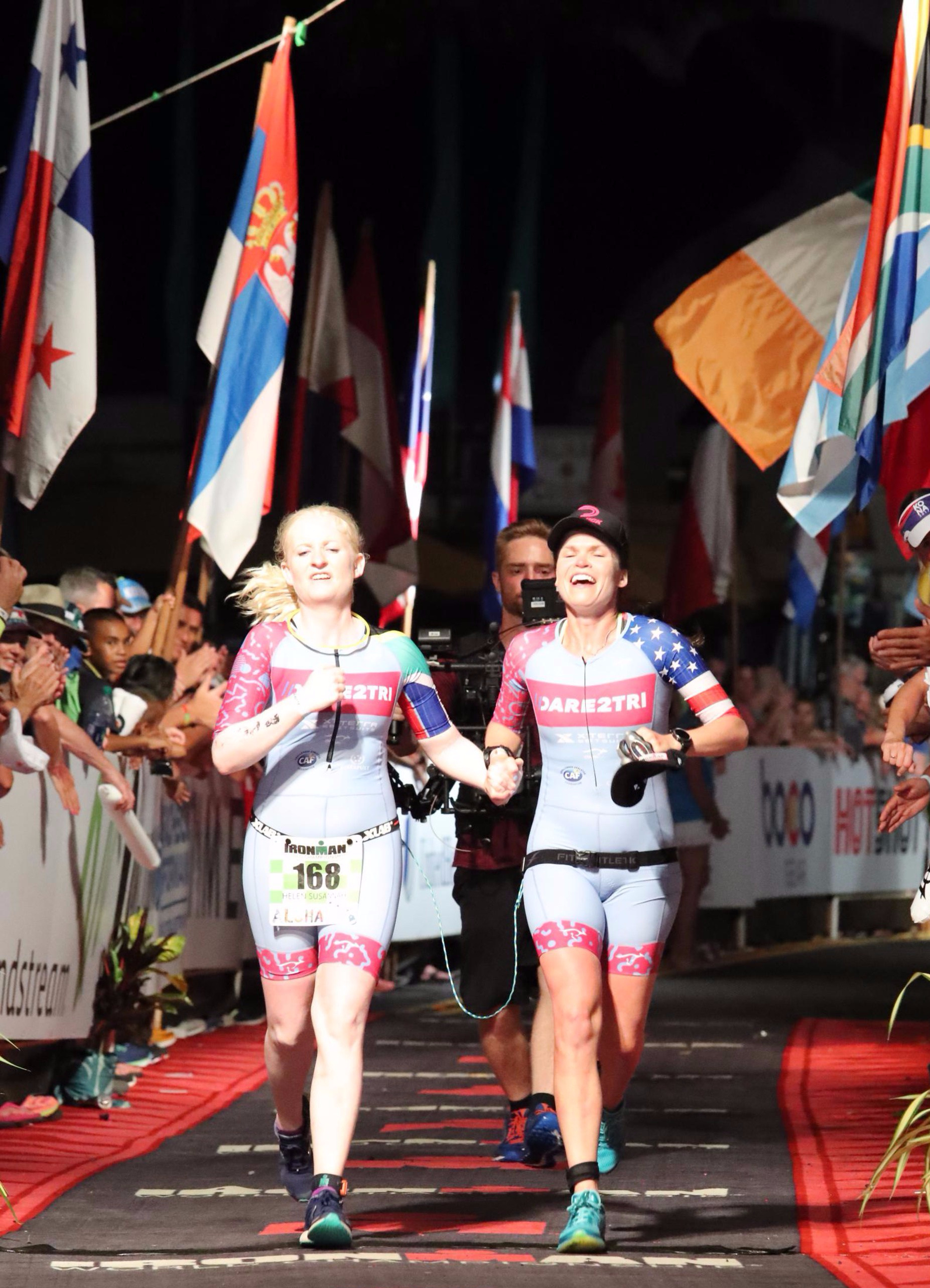
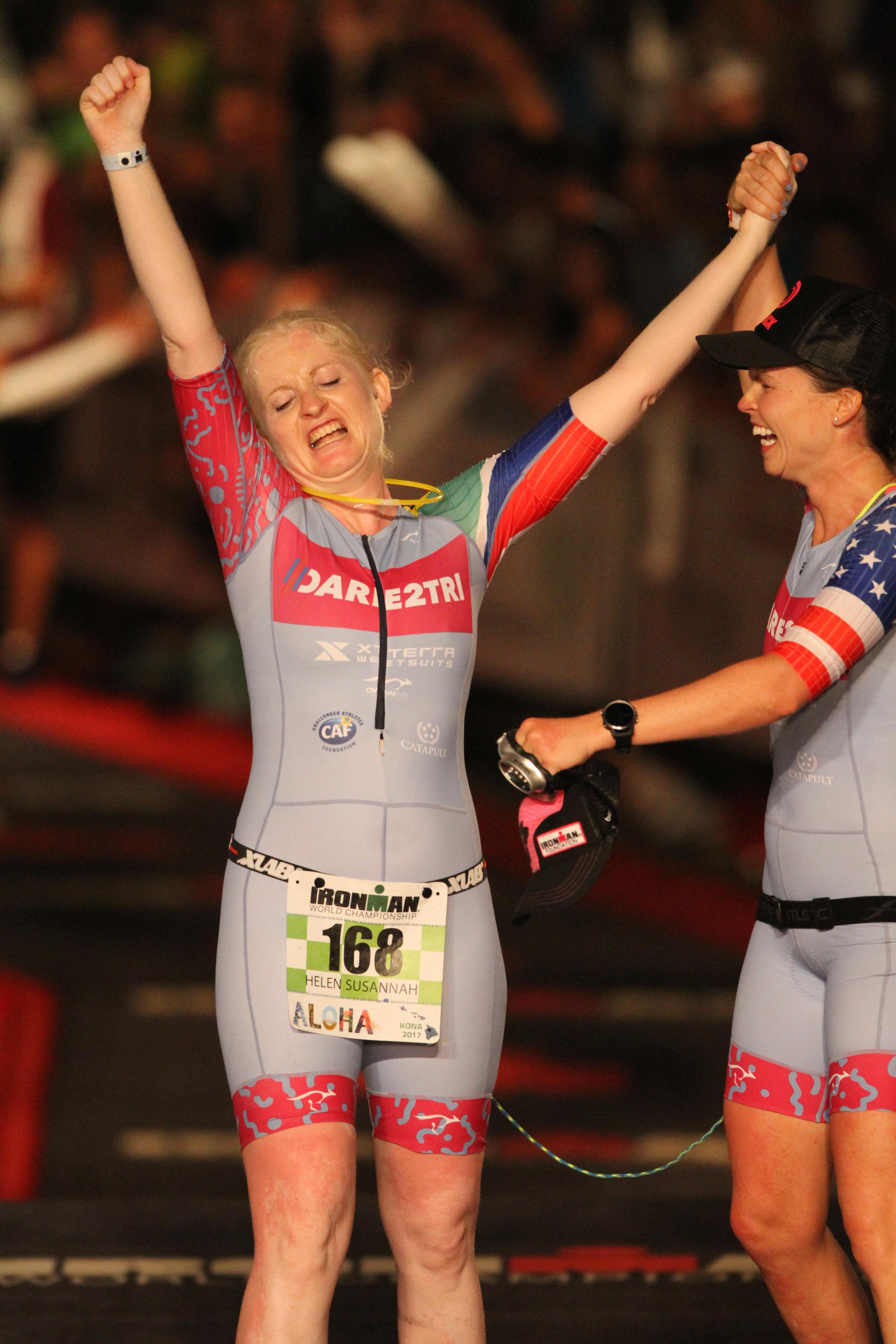
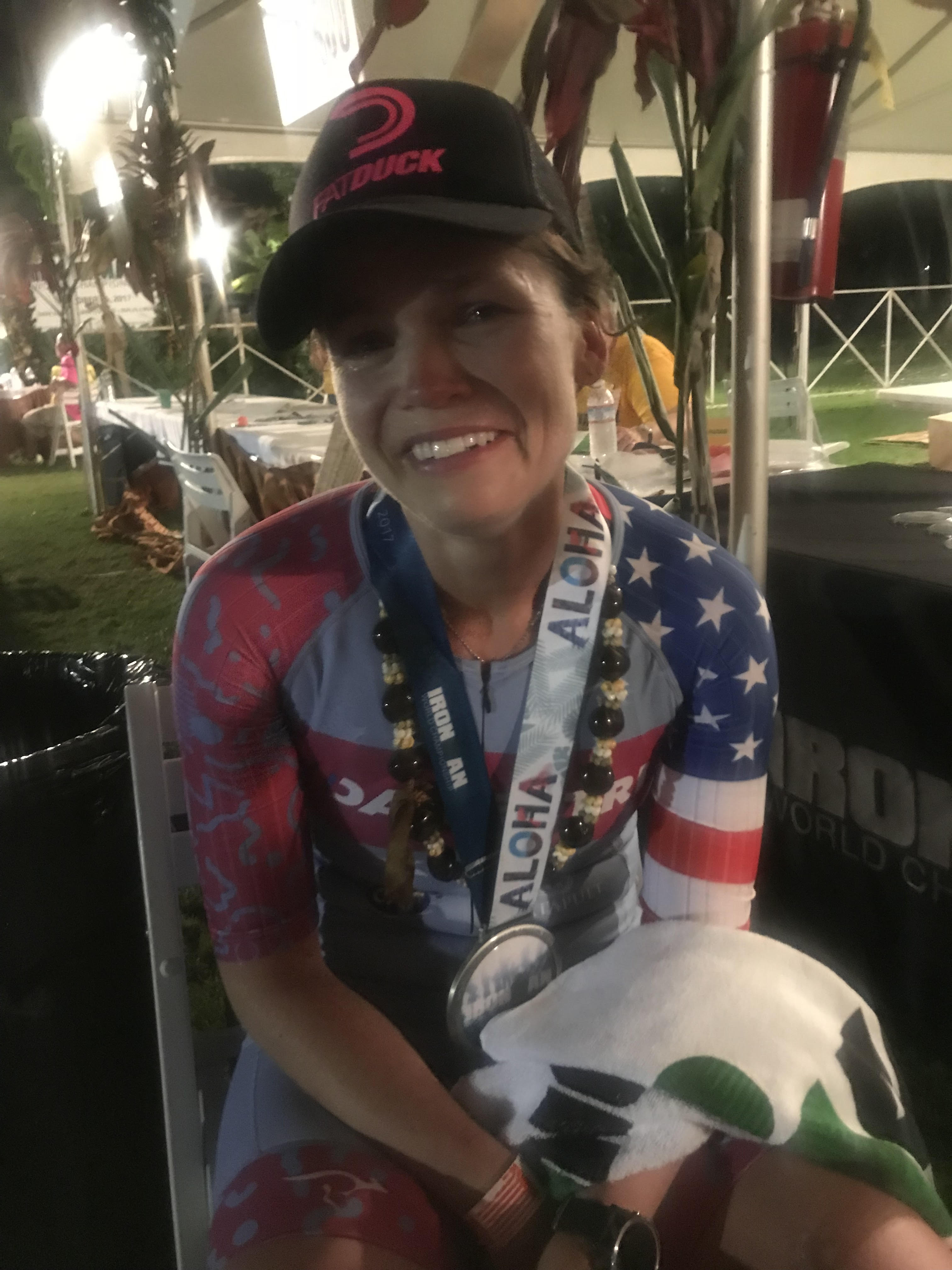
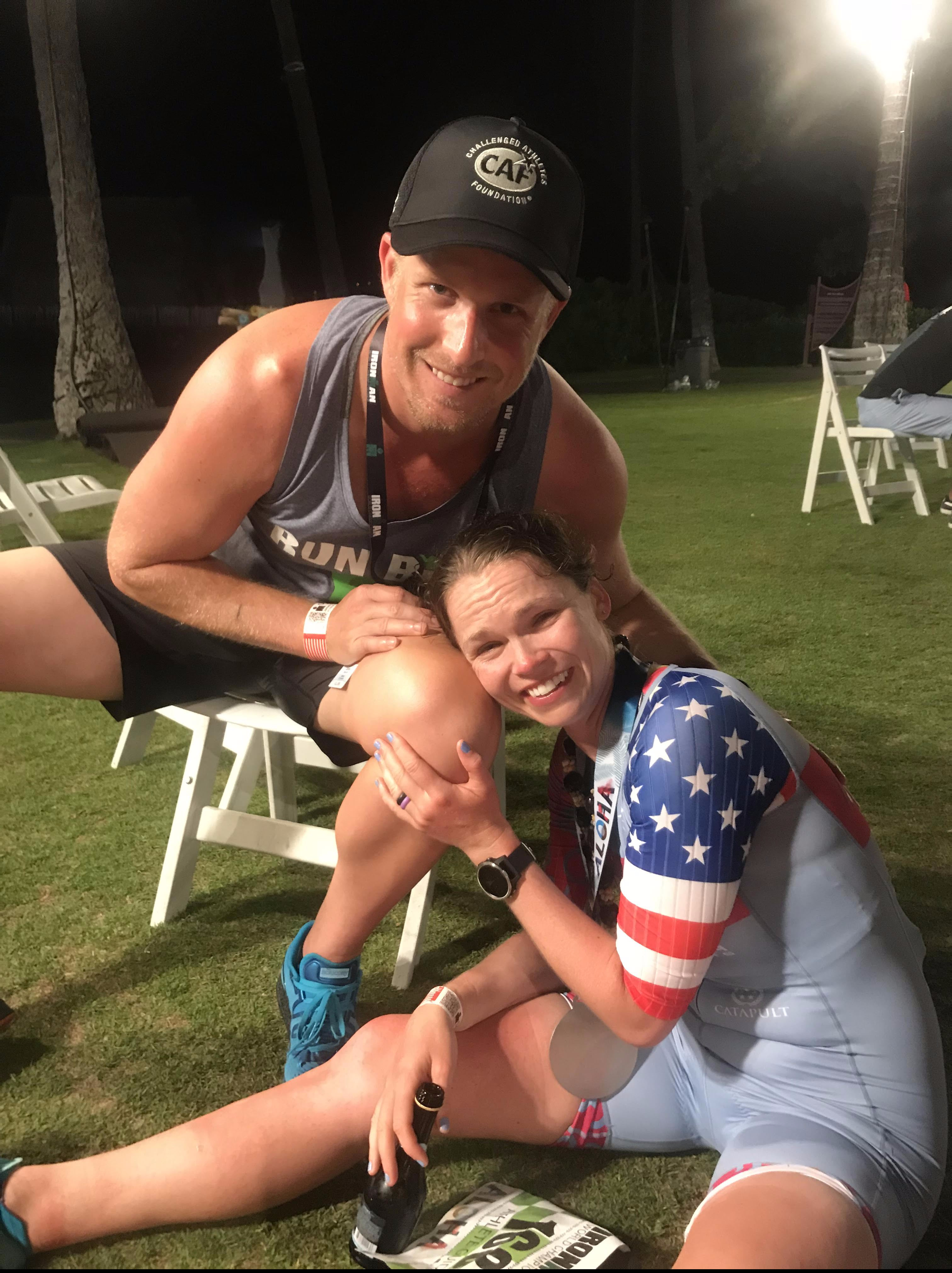

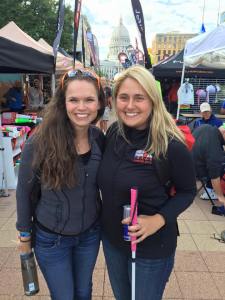
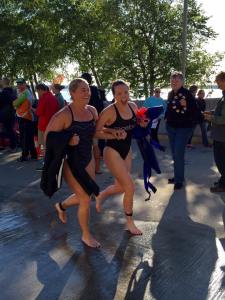

 ff the bike in an ironman, the best feeling is knowing that your equipment can’t break any more. We knew our legs could get us through the marathon.
ff the bike in an ironman, the best feeling is knowing that your equipment can’t break any more. We knew our legs could get us through the marathon.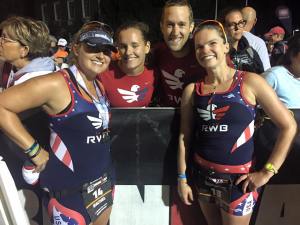
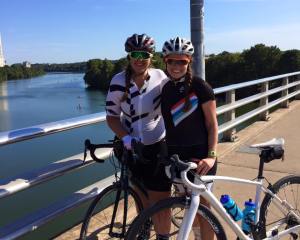
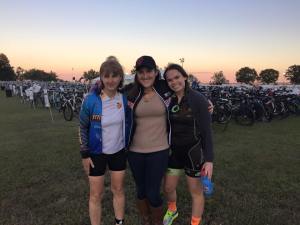

 s the first turn buoy. All of a sudden, we were surrounded by ridiculously strong athletes, trying desperately to get past us. I cannot imagine how that experience felt to Tina. But I was blown away by how well she handled the chaos. After a few minutes, we were able to figure out a good line to take and got into a good rhythm.
s the first turn buoy. All of a sudden, we were surrounded by ridiculously strong athletes, trying desperately to get past us. I cannot imagine how that experience felt to Tina. But I was blown away by how well she handled the chaos. After a few minutes, we were able to figure out a good line to take and got into a good rhythm.


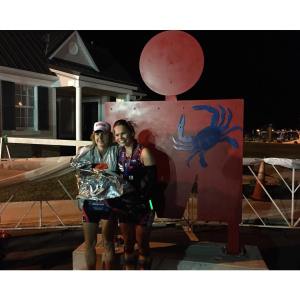

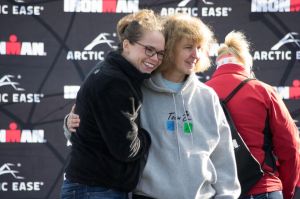
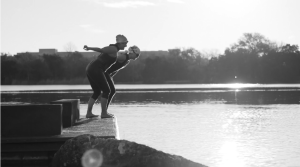 In March,
In March,